The US-A program (Radar Ocean
Reconnaissance
Satellites - RORSAT) and radio observations thereof
Sven Grahn
Summary
- a controversial space program lasting 30 years
The first inklings of a
new
Soviet space system came at the end of 1967 with the launch of
Kosmos-198
that puzzled observers. After having spent only 21 revs in a low orbit
at 265-281 km at i=65 degrees it moved up to an orbit at 894-952 km. It
was announced to have transmitted on 19.365 MHz, a hitherto unknown
frequency.
Similar flights followed, with the period in low orbit becoming
progressively
longer. (See table below).
The first indication of
what
these satellites could be intended for came in 1973, when Dr Peter
Waterman,
acting assistant secretary of the U.S. Navy for R&D testified
before
the Senate Armed Services Committee that the Soviet Union possessed
ocean
surveillance satellite based on highly maneuverable satellites.
Initially,
it was thought that the two orbits (low and high) were related to two
different
purposes. Anyway, we can now understand the series of launches leading
up to the fully operational Radar Ocean Reconnaissance Satellite
system,
called US-A (Upravlenniye Sputnik Aktivny) in Russian and RORSAT
(Radar Ocean Reconnaissance Satellite) in western terminology.
At the very end of the
1950's
Chief Designer Vladimir Chelomei's "firm" (currently NPO
Mashinostroyeniya
[Machine Building Scientific Production Association]) in the
Moscow
suburb Reutov, began studying [in the words of (4)]
"... a
whole
family of unmanned spacecraft, dubbed Kosmoplans, that would be built
using
modular elements. One variant of the Kosmoplan would conduct naval
radar
and signals reconnaissance, launched by the UR-200 rocket. In 1959, as
Chelomei laid out these plans, he knew a tremendous struggle would be
required
to wrest a piece of the space program from Chief Designer Korolev. But
Chelomei had stacked the deck against Korolev by hiring Khrushchev's
son
as a lead engineer at his OKB. By 30 May 1960 Korolev presented to the
Soviet leadership a plan that now included participation of Chelomei.
One
project allocated to Chelomei was theme US - Upravlenniye Sputnik - a
naval
reconnaissance satellite using a P6 nuclear reactor for active tracking
and targeting American warships. This was to be developed in 1962 to
1964.
Chelomei was authorized by Decree 715-296 of 23 June 1960 'On the
Production
of Various Launch Vehicles, Satellites, Spacecraft for the Military
Space
Forces in 1960-1967' to complete a draft project on unpiloted
Kosmoplans..."
The reason for the
initiative
by Chelomei's design bureau was probably that they were developing
cruise
missiles for the Soviet Navy that could be launched from small vessels
such as patrol boats, subs and destroyers. However, these missiles
needed
targeting data to get close enough to U.S. capital ships to permit the
terminal guidance radar or IR sensors to lock on the target. Chelomei's
OKB-52 had developed the P-5 "Pyatyorka" missile (SS-N-3c
Shaddock
in NATO parlance) that was declared operational on 19 June 1957 (1).
For Chelomei it must have seen logical to try to propose space systems
to provide a complete targeting and attack system.
 Nikita
Khrushchev was ousted from power on October 13, 1964. This deeply
affected
the US-A program which was the brainchild of Khrushchev's favorite
Chelomei.
Chelomei's launch vehicle the UR-200 was canceled and the US program
was
assigned to KB-1. Manager for the system at KB-1's subordinate
department
OKB-41 was Anatoli Ivanovich Savin (b. 6 April 1920), who was the head
of KB-1 (then renamed TsNII Kometa) after 1973. The spacecraft was
redesigned
for launch by the Tsyklon 2 version of Yangel's R-36 rocket. KB-1 was
also
responsible for the IS co-orbital anti-satellite program. It was under
Savin's management that the US-A system reached the flight test stage.
Nikita
Khrushchev was ousted from power on October 13, 1964. This deeply
affected
the US-A program which was the brainchild of Khrushchev's favorite
Chelomei.
Chelomei's launch vehicle the UR-200 was canceled and the US program
was
assigned to KB-1. Manager for the system at KB-1's subordinate
department
OKB-41 was Anatoli Ivanovich Savin (b. 6 April 1920), who was the head
of KB-1 (then renamed TsNII Kometa) after 1973. The spacecraft was
redesigned
for launch by the Tsyklon 2 version of Yangel's R-36 rocket. KB-1 was
also
responsible for the IS co-orbital anti-satellite program. It was under
Savin's management that the US-A system reached the flight test stage.
In May 1969 overall
management
of the US-A program was transferred to KB Arsenal in St. Petersburg. KB
Arsenal was made responsible for series production and development of
new
variants. KB-1 was still the subcontractor for radio controls and
spacecraft
control systems. Under Arsenal's management the first research and
development
spacecraft was ready for launch at the end of 1970. The US-A was
accepted
for military service in 1975.
So, the US-A system was
conceived
and designed by Chelomei in 1959-1964; redesigned and flight tested by
Savin in 1965-1969; and finally completed and put into service by KB
Arsenal
in St. Petersburg from 1969 and onwards.
| Satellite |
L/V |
Launch
date |
Days
in
LEO |
Separation
(min)
|
Remarks |
Announced
fx |
Received
signals
(nr of passes) |
| Kosmos-102 |
Vostok 11A510 |
27 Dec 1965 |
-
|
-
|
|
19.735 MHz |
- |
| Kosmos-125 |
Vostok 11A510 |
21 Jul 1966 |
-
|
-
|
|
19.735 MHz |
- |
| Kosmos-198 |
Tsyklon-2A, 11K67 |
27 Dec 1967 |
1
|
-
|
First to be
boosted to 900
km orbit |
19.365 MHz |
- |
| Kosmos-209 |
Tsyklon-2A, 11K67 |
22 Mar 1968 |
1
|
-
|
Carried reactor
simulator
as K-198 |
-
|
-
|
| Kosmos-367 |
Tsyklon-2, 11K69 |
3 Oct 1970 |
< 3h
|
-
|
First flight of
BES-5 nuclear
reactor |
19.542 MHz |
- |
| Kosmos-402 |
Tsyklon-2, 11K69 |
1 Apr 1971 |
< 3h?
|
-
|
In high orbit at
rev 5 |
-
|
-
|
| Kosmos-469 |
Tsyklon-2, 11K69 |
25 Dec 1971 |
9.5
|
-
|
First flight of
radar? |
-
|
-
|
| Kosmos-516 |
Tsyklon-2, 11K69 |
21 Aug 1972 |
32
|
-
|
Last flight of
S/C by Savin
KB. Full radar gear |
-
|
-
|
| Kosmos-626 |
Tsyklon-2, 11K69 |
27 Dec 1973 |
45
|
-
|
First flight of
updated
S/C by KB Arsenal. |
-
|
-
|
| Kosmos-651 |
Tsyklon-2, 11K69 |
15 May 1974 |
71
|
25
|
First paired
flight |
-
|
-
|
| Kosmos-654 |
Tsyklon-2, 11K69 |
17 May 1974 |
74
|
25
|
First paired
flight |
-
|
-
|
| Kosmos-723 |
Tsyklon-2, 11K69 |
2 Apr 1975 |
43
|
27
|
Orbital plane 23
deg from
K-724, n=5 |
-
|
166 MHz (16),
19.542 MHz
(1) |
| Kosmos-724 |
Tsyklon-2, 11K69 |
7 Apr 1975 |
65
|
27
|
n=5 |
-
|
166 MHz (31),
19.542 MHz
(2) |
| Kosmos-785 |
Tsyklon-2, 11K69 |
12 Dec 1975 |
< 15h
|
-
|
Boosted to high
orbit on
rev 10? |
-
|
-
|
| Kosmos-860 |
Tsyklon-2, 11K69 |
17 Oct 1976 |
24
|
38
|
Co-planar, n=3 |
-
|
-
|
| Kosmos-861 |
Tsyklon-2, 11K69 |
21 Oct 1976 |
60
|
38
|
Co-planar, n=3 |
-
|
166 MHz (21) |
| Kosmos-952 |
Tsyklon-2, 11K69 |
16 Sep 1977 |
21
|
26
|
Co-planar, n=2 |
-
|
-
|
| Kosmos-954 |
Tsyklon-2, 11K69 |
18 Sep 1977 |
43
|
26
|
Reactor landed
in Canada.Co-planar,
n=2 |
-
|
166 MHz (2) |
| Kosmos-1176 |
Tsyklon-2, 11K69 |
29 Apr 1980 |
134
|
-
|
Redesigned
reactor safety
features |
-
|
166 MHz (14) |
| Kosmos-1249 |
Tsyklon-2, 11K69 |
5 Mar 1981 |
105
|
26
|
Co-planar, n=2 |
-
|
166 MHz (14),
19.542 MHz
(12) |
| Kosmos-1266 |
Tsyklon-2, 11K69 |
21 Apr 1981 |
8
|
26
|
Co-planar, n=2 |
-
|
166 MHz (1),
19.542 MHz
(8) |
| Kosmos-1299 |
Tsyklon-2, 11K69 |
24 Aug 1981 |
12
|
-
|
|
-
|
166 MHz (3),
19.542 MHz
(11) |
| Kosmos-1365 |
Tsyklon-2, 11K69 |
14 May 1982 |
135
|
51
|
Co-planar, n=4 |
-
|
166 MHz (8),
19.542 MHz
(6) |
| Kosmos-1372 |
Tsyklon-2, 11K69 |
1 Jun 1982 |
70
|
51
|
Co-planar, n=4 |
-
|
166 MHz (6),
19.542 MHz
(2) |
| Kosmos-1402 |
Tsyklon-2, 11K69 |
30 Aug 1982 |
120
|
26
|
Co-planar, n=2.
Fuel burned
up S Atlantic |
-
|
166 MHz (9),
19.542 MHz
(6) |
| Kosmos-1412 |
Tsyklon-2, 11K69 |
2 Oct 1982 |
39
|
26
|
Co-planar, n=2 |
-
|
-
|
| Kosmos-1579 |
Tsyklon-2, 11K69 |
29 Jun 1984 |
90
|
-
|
|
-
|
166 MHz (13) |
| Kosmos-1607 |
Tsyklon-2, 11K69 |
31 Oct 1984 |
93
|
-
|
|
-
|
166 MHz (8) |
| Kosmos-1670 |
Tsyklon-2, 11K69 |
1 Aug 1985 |
83
|
26
|
Co-planar, n=2 |
-
|
166 MHz (5) |
| Kosmos-1677 |
Tsyklon-2, 11K69 |
23 Aug 1985 |
60
|
26
|
Co-planar,
n=2 |
-
|
166 MHz (1) |
| Kosmos-1736 |
Tsyklon-2, 11K69 |
21 Mar 1986 |
92
|
-
|
|
-
|
166 MHz (9) |
| Kosmos-1771 |
Tsyklon-2, 11K69 |
20 Aug 1986 |
56
|
-
|
|
-
|
-
|
| Kosmos-1818 |
Tsyklon-2, 11K69 |
2 Feb 1987 |
-
|
-
|
Test flight of
new reactor |
-
|
-
|
| Kosmos-1860 |
Tsyklon-2, 11K69 |
18 Jun 1987 |
40
|
-
|
Last flight
tracked by the
Kettering Group |
-
|
166 MHz (4) |
| Kosmos-1867 |
Tsyklon-2, 11K69 |
10 Jul 1987 |
-
|
-
|
Test flight of
new reactor
as 1818 |
-
|
-
|
| Kosmos-1900 |
Tsyklon-2, 11K69 |
12 Dec 1987 |
120
|
-
|
6-day repeat
pattern. To
high orbit 30 Sept. |
-
|
-
|
| Kosmos-1932 |
Tsyklon-2, 11K69 |
14 Mar 1988 |
66
|
-
|
|
-
|
-
|
In the low-orbit phase
the
side-looking radar, operating at 8.2 GHz, monitored US fleet movements
with power coming from a nuclear reactor. The CIA estimated (31)
that the US-A system had a "high probability of detecting
carrier-sized
ships in fair weather" and "detection of destroyer-sized ships highly
probable,
but only under the best of conditions (illuminated length-on in calm
seas)".
This report also stated that the system "cannot detect any ships in
high
seas or rain". The width of the area observed parallel to the orbital
track
was given as approximately 450 km (250 nm) by the CIA (32).
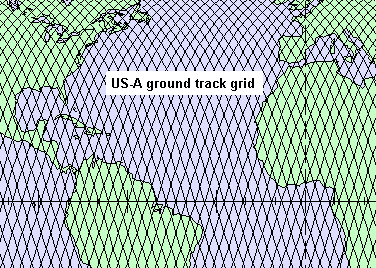 The
high orbit was a "disposal orbit" for the spent reactor where
radioactivity
would decay to less lethal levels. The reason for using a nuclear
reactor
was that solar arrays would need to be very large to power the radar
and
the high drag in the low orbit would have made the attitude control and
drag make-up problems insurmountable.
The
high orbit was a "disposal orbit" for the spent reactor where
radioactivity
would decay to less lethal levels. The reason for using a nuclear
reactor
was that solar arrays would need to be very large to power the radar
and
the high drag in the low orbit would have made the attitude control and
drag make-up problems insurmountable.
The real operational
configuration
became evident with the flight of Kosmos-651 and Kosmos-654 that
entered
the same orbital plane with a phase difference of 25 minutes in the
89.65
minute orbit. Constant small maneuvers, or rather thrusting, kept the
orbit
from decaying and the phase difference constant. These two satellites
stayed
in the low orbit phase for 71 and 74 days respectively.
The US-A program
appears
to have been a high-priority system in the Soviet arsenal. Despite
several
setbacks, failures and public embarrassment the program was pursued for
almost thirty years. The program will be remembered for its
originality,
its disasters (Kosmos-954 and Kosmos-1402),
its pollution of earth orbit with space debris and
its
interference
with gamma-ray observatories in orbit!
Repeating
orbit
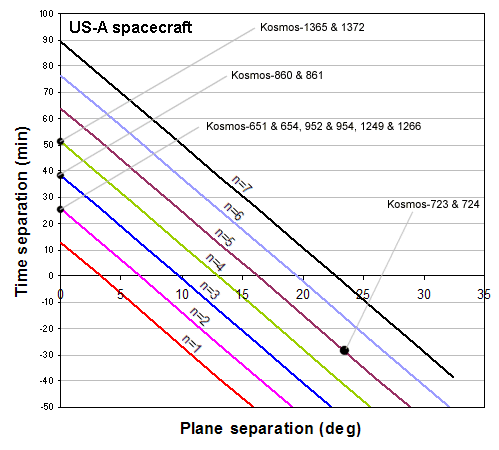 The
US-A satellites were placed in an orbit that repeated its ground track
every 111 revolutions. Repeating ground track patterns are described in
a
separate article. The parameters used to describe the US-A orbit
are
N,M,Q=16,-1,7. The resulting orbit has an average altitude above a
spherical
earth of 255.3 km and a nodal period of 89.651 minutes. Each satellite
traversed a pattern of ground tracks on the globe that formed a grid on
the earth's surface (see map on the right). When two satellites
operated
in a pair, both satellites followed the same set of ground tracks as
shown
by Nicholas Johnson (6). In addition,
the
satellites entered the typical repeating pattern orbit almost
immediately
upon orbit insertion, so that the grid on the globe was the same for
all
US-A satellites. The grid size was 3.243 degrees in longitude.
Presumably,
this fixed grid made it easier for military planners to issue tasking
orders
for imaging by the US-A spacecraft.
The
US-A satellites were placed in an orbit that repeated its ground track
every 111 revolutions. Repeating ground track patterns are described in
a
separate article. The parameters used to describe the US-A orbit
are
N,M,Q=16,-1,7. The resulting orbit has an average altitude above a
spherical
earth of 255.3 km and a nodal period of 89.651 minutes. Each satellite
traversed a pattern of ground tracks on the globe that formed a grid on
the earth's surface (see map on the right). When two satellites
operated
in a pair, both satellites followed the same set of ground tracks as
shown
by Nicholas Johnson (6). In addition,
the
satellites entered the typical repeating pattern orbit almost
immediately
upon orbit insertion, so that the grid on the globe was the same for
all
US-A satellites. The grid size was 3.243 degrees in longitude.
Presumably,
this fixed grid made it easier for military planners to issue tasking
orders
for imaging by the US-A spacecraft.
Johnson
(6)
also showed that, even when satellites were co-planar, the
temporal
spacing in the orbit was chosen so that the two satellites followed
parallel
grid lines, with 1,2 3,... grid sizes spacing. the picture below shows
the relationship between temporal and orbital plane spacing for various
values of n, where this parameter denotes the number of days between
passes
of two spacecraft along the same grid line.
Not only did the US-A
spacecraft
work in pairs. Their orbits were also closely linked with the passive
ELINT
ocean reconnaissance satellite system denoted US-P which also used a
repeating
pattern with a fixed grid over the Earth. The US-P spacecraft are still
in use and they have operated in pairs in coordinated orbital planes.
However,
they have always maintained orbits with a well defined repeating
pattern.
These spacecraft use an orbit at i = 65 degrees and a nodal period of
93.30
min, which corresponds to an average altitude of 434 km. This turns out
to be an orbit with the parameters (N,M,Q)=(15, 1, 4) which corresponds
to a ground track that repeats every 61 orbits.
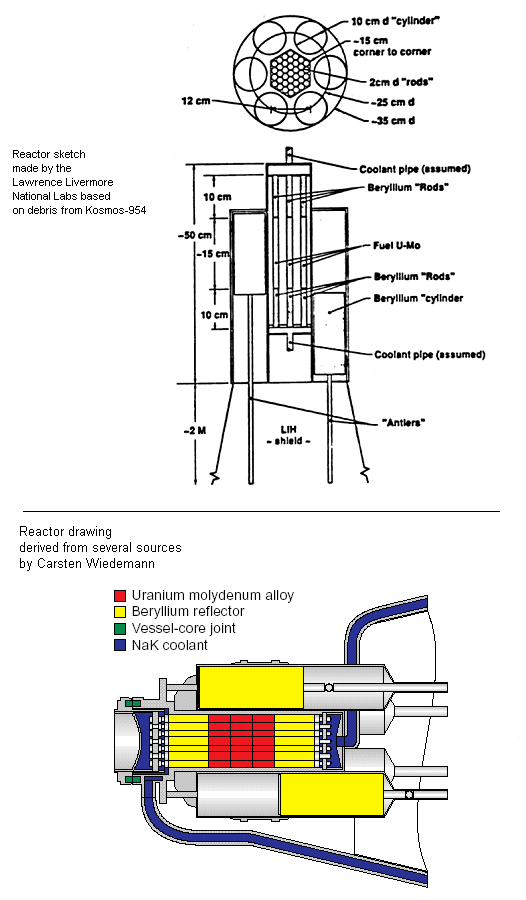 The
reactor
The
reactor
The Buk reactor on the
US-A
spacecraft was a fast neutron reactor that used a uranium-molybdenium
alloy
as fuel contained in 37 steel clad rods about 0.6 m long. The fuel core
of the reactor was 0.2 m in diameter, 0.6 m long and weighed, as an
assembly,
53 kg (37). The 30 kg of
uranium
was more than 90% enriched U235 (39).
It generated 3 kW of electrical power (38)
created by thermoelectric conversion of 100 kW of thermal output. The
reactor
weighed 385 including the radiation shielding. The radiation shield
consisted
of LiH and stainless steel supplemented by tungsten and uranium alloys
(39).
The reactor itself, including the fuel weighed 130 kg (35).
The reactor was controlled by six cylindrical control elements made of
beryllium that could reciprocate along the reactor axis. The rods
(racks, "antlers") that drive the control cylinders are filled with
reactor
poison BC2
to prevent
a "leakage" of radioactivity through the radiation shield (41).
It is interesting how much scientists outside the Soviet was able to
deduce
about these technical details by examining the pieces falling to earth
as a result of the Kosmos-954 accident (see below).
The top sketch (40) on the
right
was put together by scientists at the Lawrence Livermore National
Laboratories
which turned out to be quiter accurate when comapring it to later
sketches
provided by Russian authorities
(37).
The main propulsion
system,
was there an ion thruster?
In (1)
the on-orbit propulsion system of the US satellite type (both the radar
-equipped and the ELINT version) is described as consisting of a
relatively
powerful engine for orbital insertion medium thrust engines for orbital
corrections and motion, and very economical low-thrust stabilization
engines.
The main propulsion
unit
for orbit insertion, orbit maintenance and attitude control was the
4E18
propulsion system using N2O4
and UDMH as propellant. It was designed by the Soyuz Turayev
Machine-Building
Design Bureau. Its overall mass including propellant was 910 kg. The
4E18
propulsion system is the green section on the right-hand part of the
spacecraft
as shown in the figure above. It is 1300 mm in diameter and measures
1332
mm long (33). The propellant mass can
estimated
by the data given in (33). As a space tug
weighing
1000 kg and with no payload the tug can raise its orbit from a circular
orbit at 200 km to an orbit ranging between 200 km and 23000 km. This
requires
a delta-V of 2150 m/s. By using an Isp for UDMH/N2O4
of 316 sec one can compute the propellant mass to be 500 kg.
In (2)Geoff
Perry (leader of the Kettering Group) describes how he found
a lower limit on the continuously operating engines that he found could
explain the motion of US-P satellites. He gives a figure of 8.5
·
10-7 N/kg. With a mass of 3000 kg this corresponds to 2.6
mN,
which is quite a small engine. For the US-A a much more powerful engine
would be needed due to the higher drag. Ion propulsion has been assumed
to provide continuous thrust. It is interesting to analyze the motion
of
US-A satellites to try to find evidence showing which propulsion regime
that was used for the US-A. It turns out that there is evidence for
both
continuous and impulse maneuvers to keep the orbit at a very precise
period.
the graph on the left
shows
the orbital period for Kosmos-723 and the increase in period is
monotonic.
There is absolutely no sign of a downward motion. However, the orbit of
Kosmos-1402 drops in orbital period for a couple of days before an
impulse
raises the orbit. It seems that two different propulsion systems were
used.
In another case it
seems
that both types of propulsion may have been used. The figure below
shows
also the interesting affect that the precision if the control of the
orbital
period changed with time, from lower precision to high precision and
then
back to lower precision. This could be a result of the orbit
determination
process of the United States space tracking network, but his is
difficult
to determine so long after actual events.
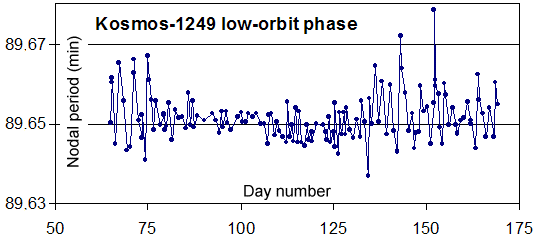
Configuration
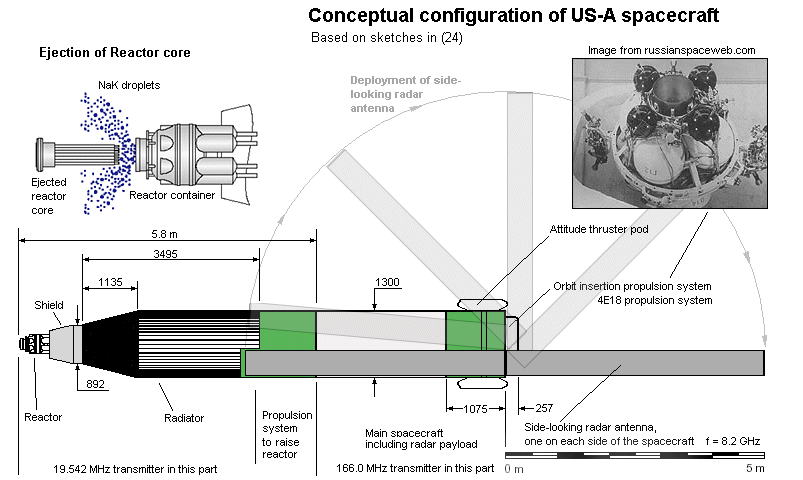
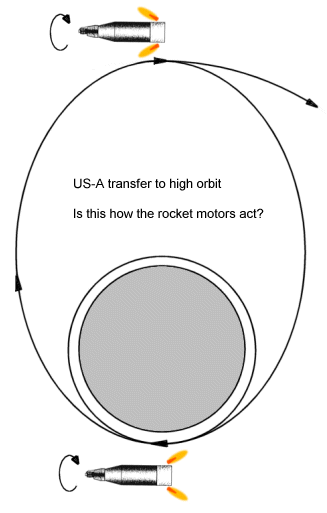 The
ascent to high orbit
The
ascent to high orbit
The propulsion system used
to
raise the reactor to the high orbit provided two impulses. The first
put
the reactor assembly on a transfer orbit to the high orbit and amounted
to about 198 m/s. The second maneuver "circularized" the orbit at the
high
altitude and amounted approximately to 175 m/s. So, the total delta-v
provided
by this propulsion system was 373 m/s. If one assumes a very modest
specific
impulse of 2.7 km/s the mass fraction needed to provide this impulse is
about 1.15, i.e. 15% of the mass of the vehicle that ascended to the
high
orbit was propellant. The overall dry mass mass of ascent stage was
1250
kg (35). Thus, the propellant mass
can
be computed to be 101 kg for the first impulse plus 89 kg for the
second
impulse. The total propellant mass amounted to approximately 190 kg.
The vehicle that ascends to the high orbit must have
its own attitude control system that is independent from the rest of the
vehicle. It seems that Soviet designers chose spin stabilization (34). The ascent
stage
would have been spun up immediately after separation from the main
vehicle.
Solid propellant rockets at the rear of the ascent stage would the fire
to raise apogee and half an orbit later rocket motors located in the
same
part would have fired again. However, the spin axis of the ascent stage
would remain fixed in inertial space during the ascent to apogee, so
the
rocket motors that fired at apogee had their direction of action in the
opposite direction compared to the first set of motors. The sketch on
the
right shows how the situation could have looked.
The example of Kosmos-1900 (see below)
is interesting. Even though radio contact was lost with the craft in April of
1988 its reactor and attitude control system operated until 30 September of that
year when stabilization was lost triggering the ascent to high orbit ( ).
Aerodynamic forces seemingly caused the longitudinal axis to deviate too much
from the direction of flight. That triggered separation, spin-up and ignition of
the first set of solid rocket motors.
The ascent vehicle is 5.8 meters long and 1.3 m in
diameter (35). The picture below is of Soviet origin
and was shown in (36). The radiator
was a 0.4 mm thick copper sheet with embedded copper tubes with 8 mm diameter
and 0.5 mm thickness. There were 120 such tubes around the perimeter of the
satellite body aligned with the longitudinal axis of the spacecraft and spaced
at 34 mm distance. The radiator was supported by a framework as seen in the
picture below.
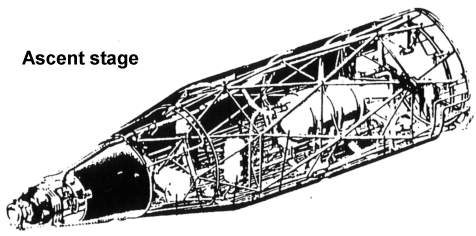
The sketch shows the total length of the ascent
vehicle, it seems. However, there is no sign in the sketch above of the
propulsion system used to raise the orbit.
Telemetry systems
 The
Kettering Group, to which I have belonged since
1966, initially had difficulties finding the signals from the US-A system, (see
separate article), but in 1975 two factors contributed
to success. First, my friend Dick Flagg purchased a 55-260 MHz telemetry receiver with a spectrum display
unit for me and had it shipped to Sweden. This was a powerful tool in
finding new signals. Within months of bringing that receiver in operation I had
identified PPM-AM telemetry on 166.0 MHz from US-A satellites.
The second factor was the launch of Kosmos-723 and Kosmos-724. These satellites
transmitted extensively including on short waves. Therefore the Kettering Group
finally found also the 19.542 MHz FSK-PDM telemetry from the US-A system when I succeeded
in picking up this signal from Kosmos-723 on 26 April 1975. As time went by we
were able to determine that the 166 MHz transmitter was in the main spacecraft
bus that remained in low orbit and the 19.542 MHz transmitter was placed in the
part of the spacecraft that was raised to the "storage" orbit (see Kosmos-1299
below). Observations of many US-A missions showed that the short-wave signals
were very rare during the low-orbit phase of the mission, but much more frequent
in the high orbit, "storage" phase of the flight. Perhaps the HF beacon was used
to monitor the status of the reactor. More details about telemetry receptions
and formats will be given below when each mission is examined.
The
Kettering Group, to which I have belonged since
1966, initially had difficulties finding the signals from the US-A system, (see
separate article), but in 1975 two factors contributed
to success. First, my friend Dick Flagg purchased a 55-260 MHz telemetry receiver with a spectrum display
unit for me and had it shipped to Sweden. This was a powerful tool in
finding new signals. Within months of bringing that receiver in operation I had
identified PPM-AM telemetry on 166.0 MHz from US-A satellites.
The second factor was the launch of Kosmos-723 and Kosmos-724. These satellites
transmitted extensively including on short waves. Therefore the Kettering Group
finally found also the 19.542 MHz FSK-PDM telemetry from the US-A system when I succeeded
in picking up this signal from Kosmos-723 on 26 April 1975. As time went by we
were able to determine that the 166 MHz transmitter was in the main spacecraft
bus that remained in low orbit and the 19.542 MHz transmitter was placed in the
part of the spacecraft that was raised to the "storage" orbit (see Kosmos-1299
below). Observations of many US-A missions showed that the short-wave signals
were very rare during the low-orbit phase of the mission, but much more frequent
in the high orbit, "storage" phase of the flight. Perhaps the HF beacon was used
to monitor the status of the reactor. More details about telemetry receptions
and formats will be given below when each mission is examined.
Kosmos-102 & Kosmos-125
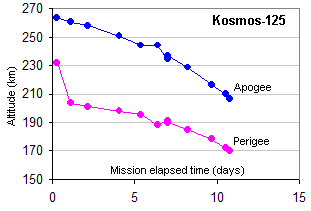 Kosmos-102 was launched
at 2219 UT on 27 December 1965 from site 31 at Baikonur by a version of
the R-7 rocket (1). No two-line element sets are available for
this satellite, but the RAE Table of Earth satellites gives the orbit as 203-269
km, i=64.97 with a lifetime of 17 days. In a letter to the editor of Flight
magazine Geoff Perry pointed out that Kosmos-102 did not transmit on its
announced frequency and noted that it was unlike reconnaissance Kosmos
satellites because of its uncharacteristic launch time, natural decay and lack
of upper stage in orbit (19).
Kosmos-102 was launched
at 2219 UT on 27 December 1965 from site 31 at Baikonur by a version of
the R-7 rocket (1). No two-line element sets are available for
this satellite, but the RAE Table of Earth satellites gives the orbit as 203-269
km, i=64.97 with a lifetime of 17 days. In a letter to the editor of Flight
magazine Geoff Perry pointed out that Kosmos-102 did not transmit on its
announced frequency and noted that it was unlike reconnaissance Kosmos
satellites because of its uncharacteristic launch time, natural decay and lack
of upper stage in orbit (19).
Kosmos-125 was launched at 0907 UT on 20 July 1966
using the same type of launch vehicle and the same launch pad as the previous
satellite of this type. It decayed after 13.23 days. The initial orbit was
205-258 km. Orbital data for the entire life of the satellite are available (see
figure). Contact was maintained with the spacecraft until the 52nd orbit (1).
The CIA's National Intelligence Estimate 11-1-67
was handed to President Johnson in March 1967 and read concerning Kosmos-102 and
Kosmos-125:
"... Another propulsion system was probably used to
effect minor changes in the orbit. A probable mission of these satellites was
to evaluate the injection and orbit-adjust maneuver propulsion engines and the
vehicle attitude control system. Such systems may be incorporated into an
improved manned spacecraft ..." (18).
So,
it seems that at this early stage the CIA did not
have a clue! However, it is possible that the plot of apogee and
perigee shows signs of orbit changes for Kosmos-125, especially the jump in
perigee at almost constant apogee height at the beginning of the flight.
Such a maneuver would be performed near the northern apex since the perigee was
over the southern hemisphere (argument of perigee approximately 270
degrees). The rest of the data for Kosmos-125 is suggestive of natural
decay.
The purpose of these two flights could be to test
the spacecraft's own propulsion system that was used to insert the spacecraft
into orbit. Probably, onboard systems such as attitude control were tested.
Neither the nuclear power source nor the radar were installed.
Kosmos-198
The first US-A
spacecraft that looked reasonably like the final system was Kosmos-198 that was
launched from Baikonur LC90/19 at 1128 UT on 27 December 1967 by a version of
the operational rocket for the system, Tsiklon-2A. It entered an orbit at
266-270 km with a period of 89.86 minutes and moved to the high orbit late on 28 December after 21
revolutions (2). So, this was the first flight that included
the attitude control and two-impulse propulsion system to bring the spacecraft
to the high orbit. It is unclear if there were maneuvers made during the first
21 revolutions. Only one element set exists for the low orbit. The spacecraft
carried chemical power sources only. The first available element set for the
high orbit is valid for the afternoon of 29 December with altitudes 895-951 km.
This spacecraft caused a lot of confusion in the Kettering Group since the TASS
announcement said it transmitted on 19.365 Mhz, the same frequency given for the
failed lunar probe Kosmos-111, launched in the spring of 1966. We heard no
signals from either of the, but because of the frequency similarity, we thought
Kosmos-198 was related to the lunar program, and we were nor alone in thinking
so, but the problem of Kosmos-198 continued to bother us.
Kosmos-209
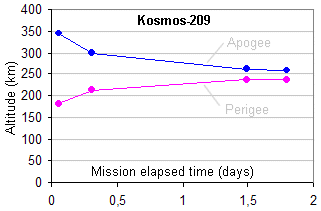 Kosmos-209 was launched from Baikonur at 0930 UT on 22
March 1968. The Kettering Group instantly spotted this satellite to be similar
to Kosmos-198. Here is what Geoff Perry wrote (21):
Kosmos-209 was launched from Baikonur at 0930 UT on 22
March 1968. The Kettering Group instantly spotted this satellite to be similar
to Kosmos-198. Here is what Geoff Perry wrote (21):
"...Cosmos 209 has turned out to be another Cosmos 198,
changing its orbit after 17 revs. The initial period of 89.5 minutes is now
103.05 minutes and the orbit is near circular between 893.3 and 945.6
km.
Geoff Perry was right
except that it changed its orbit later than he thought. The first element set
for the higher orbit appears after 29 revolutions. However, there is a fragment
fragment B (cat nr 3160) in the low orbit with its epoch at day 83.82248, which
is 1.4267 days after launch which is rev 23. There is a C object in low orbit
(cat nr 3161) at epoch 84.25439 which is 1.859 days after launch or on
revolution 30. So, the maneuver took place at some time between revolution 23 and 29.
The evolution of the apogee and perigee of the
spacecraft is shown on the right. It seems that the apogee and perigee converge
while the orbital period drops. If this convergence is a real effect of
maneuvers or an artifact caused by better and better estimate of the
eccentricity is hard to determine this long after the event.
Kosmos-367
Kosmos-367 was launched
1026 UT on 3 October 1970. An object was logged in an orbit at 241-267 km
already 0.367 days after launch. The high orbit was logged even earlier at 0.339
days mission elapsed time (corresponds to rev 5) at 910-1031 km. It is therefore
not so strange that TASS announced the high orbit in its communiqué about the
mission. The two earlier flights (Kosmos- 198 and -209) that had moved up were
announced with their low orbit parameters. This flight is widely regarded as the
first flight with a live reactor (1). However, it seems that
something went very wrong, so the reactor was immediately boosted to high orbit.
TASS announced a transmission frequency for Kosmos-367 at 19.542 MHz, a
frequency that was used through much of the future program up until at least
Kosmos-1402. For some reason Soviet authorities wanted the world to know this
frequency, which is a bit strange considering the otherwise very secret nature
of the US-A program..
Kosmos-402
Kosmos-402 was launched
at 1129 UT on 1 April 1971. There was an object (cat nr 5105) in the high orbit
already 0.332 days after launch in an 951-1035 km orbit. There were B and C
object in the lower orbit. The first C-object epoch was 0.492 after launch and
the orbit was 240-264 km. The short time in low orbit indicates that this was
not a particularly successful flight.
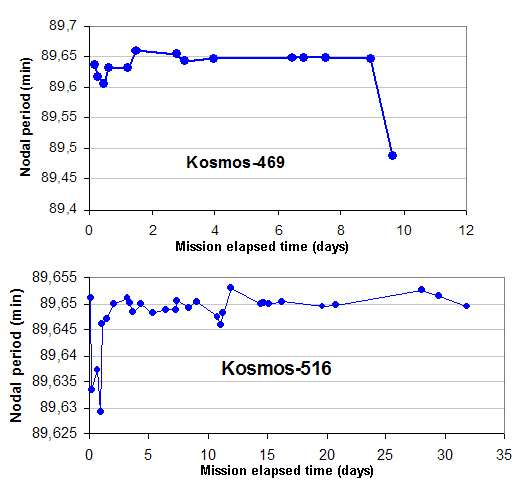 Kosmos-469
Kosmos-469
Kosmos-469 was launched at 1130 UT on 25 December 1971.
This was the first US-A flight confirmed by Russian source to have had the BES-5
nuclear reactor (4). This is in
contradiction to (1) where Kosmos-367 is regarded as the first
craft with the reactor. This spacecraft carried an active radar, perhaps for the
first time. It moved up to the high orbit on 4 January 1972. It seems that
Kosmos-469 may have been the spacecraft where the tight orbit control worked for
the first time.
Kosmos-516
Kosmos-516 was launched
at 1036 UT on 21 August 1972. Sources say that this was the first US-A to carry
complete radar system into orbit (1). The spacecraft moved to
the high orbit on 21 September after 514 revolutions, i.e. 31.8 days. The plots
of orbital data on the right for this and the previous flight seems to indicate
rather sparse tracking of the satellites. Perhaps those in charge did not fully
comprehend what these satellites were or how they operated. For later missions
much more dense tracking information is available.
Kosmos-626
In his diary for 28
December 1973, Geoff Perry wrote:
"... news of Cosmos 626 from TASS. 65 degree, 89.7 min,
257-280 km. Is this a new two-tone? Probably not since perigee is high. Other
satellites with this inclination and orbit have been C.402, 469 and 516 - the
type that suddenly maneuver up to a 104 min period after varying times in low
orbit? Perhaps this is another engine test like these? ..." (17).
Kosmos-626, the first US-A satellite to carry out a nominal
mission was launched at 2019 UT on 27 December 1973. Interestingly enough,
in an national Intelligence Estimate published on 20 December 1973 the CIA had
been able to use previous launches to correctly identify the purpose of these
satellites (1). Probably the appearance on the two previous
vehicles (K-469 & K-516) of an operating radar must have given analysts a
firm clue to the character of the system. The general public was still in the
dark as the quote from Geoff Perry's diary shows. The satellite was boosted to
the high orbit on 11 February 1974 after 45.3 days.
Kosmos-651 & Kosmos-654
Only 139 days after
Kosmos-626 another US-A satellite was launched on 15 May 1974 when Kosmos-651
took off from Baikonur at 0730 UT. A mere two days later a surprise took place.
This is what Geoff Perry wrote:
"..yet another launch. 65 degrees, 89.6 min. Looks like
another ocean-surveillance type. New satellite is 25 minutes ahead of of C.
651 and since in same orbital plane, is consequently 6.4 degrees further east
in ground track. Is this a replacement or are the two working as a pair? We
will have to wait and see..." (15).
Kosmos-654 had been launched at 0653 UT. At this time, no
signals had ever been received from the US-A type of satellite so the assessment
of these spacecraft had to be based entirely on analysis of orbital data slowly
filtering in from Goddard Space Flight Center. But a few weeks after the launch
the situation was clear. Let me quote Geoff Perry again:
"... C.651 and C-654 have
BOTH maintained their initial orbital period and track separation. This
implies that both are operational and are receiving micro-thrust orbit
corrections..." (16).
Kosmos-651 moved to the high orbit on 25 July 1974, after
71 days, and Kosmos-654 performed this maneuver on 30 July 1974, i.e. after 74
days.
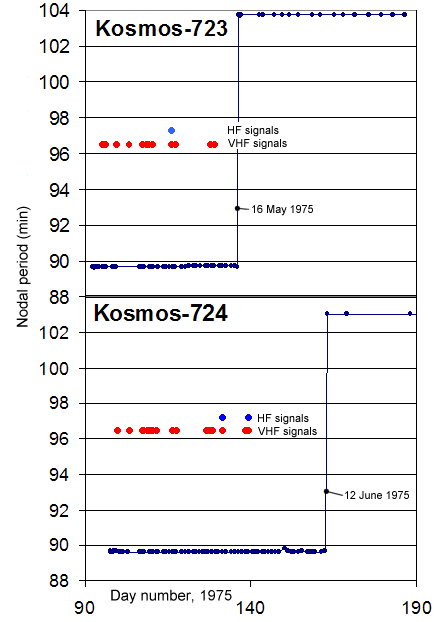 Kosmos-723 & Kosmos-724
Kosmos-723 & Kosmos-724
Kosmos-723 was launched from Launch Complex 90 at Baikonur
at around 1100 UT on 2 April 1975 (4). The launch vehicle stages were all
suborbital and the satellite put itself into an initial orbit at 247.3-268.3 km
above a spherical Earth. Its companion spacecraft Kosmos-724 was launched from
from the same site at around 1100 UT (4) on 7 April 1975. The initial orbit
was at 248.0-266.2 km, very close to that of Kosmos-723.
Again there was a 27-minute difference in passing
the equator with Kosmos-723 leading. However, the orbital planes of the two
craft were displaced by 23 degrees in longitude. In (2) Geoff
Perry describes how he, as Senior Science Master at the Kettering Grammar
School, gave the plotting of orbital data of these two spacecraft to two pupils,
Stuart Ganney and John Kellet. They quickly found that both spacecraft were
making small maneuvers to maintain the 89.65 minute period and that it seemed
that these maneuvers were made in unison as if stationkeeping. However,
Kosmos-723 gradually increased its orbital period (see "ion thrusters" above) and this
led to the decrease in time difference at the equator. By early May the time
difference was close to zero.
Four days after the launch of Kosmos-723, I was
able to pick up PPM-AM telemetry on 166.0 MHz from the spacecraft on three
passes. It seemed that the spacecraft was commanded from a site to the east of
Moscow, because signals started when the craft was over the Baltic, far above
the radio horizon of Moscow. In general Kosmos-724 transmitted more during
passes further to the east than Kosmos-723 (3).
The launch of the US-A spacecraft coincided with a
surge in Soviet reconnaissance satellites and large-scale Soviet naval
maneuvers. The Okean 75 naval war games were conducted 15-17 April in the
Atlantic, Mediterranean, Pacific and the Indian Ocean. At one point there were
three reconnaissance satellites in orbit, Kosmos-720 (two-tone signals on 19.995 MHz received by the
Kettering Group), Kosmos-721 area survey satellite (FSK-PDM signals on 19.994 MHz picked up), and
Kosmos-722 close-look spacecraft (two-tone signals on 19.989 MHz).
On 26 April 1975 I was able, for the very first
time, to pick up signals on short-waves from a US-A spacecraft, Kosmos-723, on
19.542 MHz. This frequency had been known during eight years but eluded us. Upon hearing the signals I immediately
phoned Geoff Perry and he tuned it on his radio as were were speaking! The
spacecraft was still in low orbit and had not moved up to the high storage
orbit. Kosmos-724 also transmitted on 19.542 MHz a few times on the low orbit.
The first time was on 11 May 1975. Kosmos-723 was launched to high orbit on 16
May and Kosmos-724 on 12 June. In October of 1975 the system was declared
operational (1).
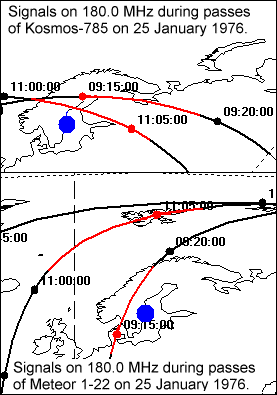 Kosmos-785
Kosmos-785
This satellite appears to be somewhat of a mystery. It
moved very quickly (after rev. 10) to the high orbit after its launch at 1245 UT
(4) on 12 December 1975. The move to the
higher orbit was probably commanded from Kamchatka as it came into view from
Soviet soil again early on 13 December 1975 after having left the zone of
visibility over Western Russia the evening before.
There have even been doubts as to it being a US-A
spacecraft. I am the the source of this doubt. I picked up PPM-AM signals twice
on 25 January 1976 on 180.0 MHz. The signals were brief but strong. The signals
matched the passes (0914-0919 UT, 1101-1106 UT) of Kosmos-785 very well (see map
below). However, these signals also match the passes of Meteor 1-22 very well.
Since signals on 180 MHz were quite common from the Meteor-1 series, I think
that one can safely say that Kosmos-785 did not transmit on 180 MHz that day in
January 1976.
The reason I thought that they came from Kosmos-785
was more the result of lack of orbital data for other satellites to calculate
passes. remember, this was in the days well before the Internet and getting
access to all those element sets to run against a certain set of observations
was a very tedious task. Now, with the availability of old element sets via the
Internet and easy-to-use software for computing passes, this old mystery can now
be cleared up. Probably Kosmos-785 transmitted on the usual frequencies, but we
just missed the signals because of the short duration of the
mission.
Kosmos-860 & Kosmos-861
After Kosmos-860 moved up late on 10 November 1976 I was
unable to pick up any VHF signals from it. I certainly heard Kosmos-861 in the
low orbit (as I had done with Kosmos-860?)
Denys Hibbins in Nunhead outside London picked up
signals on 19.542 MHz in the evenings during the period 13-21 November but
thought they were from Kosmos-861, which was still in the low orbit. Geoff Perry
analyzed the reception log on 23 November and found that signals came 21 minutes
later every day. Therefore the orbital period had to be 1440+21 divided by 16,
15, 14, 13 or 12 giving orbital period values of 91.3, 97.4, 104.4, 112.4 or
121.75 minutes. At that point it was obvious that the signals came from
Kosmos-860 in the high orbit with a period of 104.33 minutes. So, the short-wave
transmitter operated in the high orbit. We had thought that the spacecraft was
completely inactivated in the high orbit because of the lack of VHF
transmissions. Now it seemed that the short-wave transmitter relayed some sort
status information, possibly about the status of the deactivated reactor. Denys
Hibbins picked up no more short-wave signals from Kosmos-860 after 23
November.
Denys Hibbins again picked up FSK-PDM signals on
short-waves, this time on 19.545-19.547 MHz on 22, 28, 29 and 30 December
1976. Geoff Perry also picked "weird" signals on 19.547 MHz on 31 December
at 0023-0028 UT and on 1 January 1977 at 2319-2323 UT. These turned out to have
come from Kosmos-861 which moved to the high orbit on 20 December 1976. Geoff
Perry speculated in his day-to-day log on 1 January 1977 that "these signals are used to check out the payload in the
high orbit prior to its eventual shut-down".
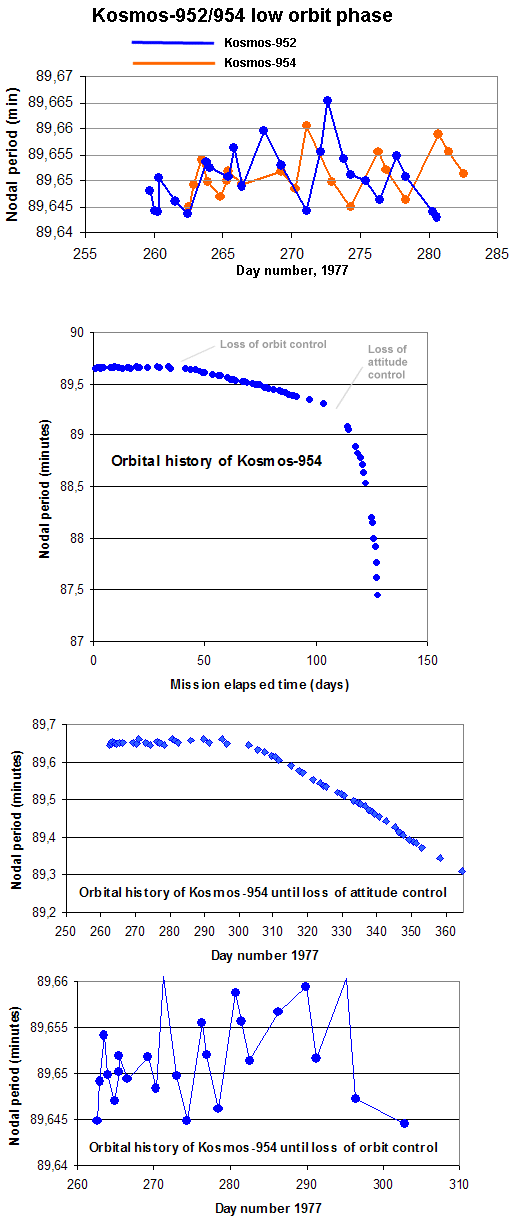 Kosmos-951 & Kosmos-954, a
near-disaster
Kosmos-951 & Kosmos-954, a
near-disaster
Kosmos-952 was launched
at 1425 UT on 16 September 1977. Kosmos-954 was launched at 1348 UT on 18
September 1977. The three lower graphs on the right show the evolution of the
orbit of Kosmos-954 in three views: the entire mission, up until loss of
attitude control and up until loss of orbit control and maintenance. The top
graph shows the evolution of the orbital period of both spacecraft during the
low-orbit phase of Kosmos-952. A quick examination of the graph gives the
impression that the maneuvers of the two spacecraft were coordinated, but with a
short delay. Interestingly, while the orbit of Kosmos-954 was being controlled
and Kosmos-952 was still in the low orbit the orbital period was kept at the
same average. But after the loss of Kosmos-952 the period of Kosmos-954 appears
to have increased slowly.
It seems that orbit control lost in the period
23-29 October 1977. The last point in the bottom graph still does not show that
the spacecraft had complete lost control, because the reduction in period from
the previous available data point was not typical of unhindered decay under
attitude control. So, presumably control was lost on that day or the days
immediately thereafter, perhaps on 1 November 1977.
Weiss (5) has given the details of how the
Kosmos-954 crisis was handled in the U.S.A. In November 1977 US intelligence
sources determined that the Kosmos-954 was experiencing difficulties. On 1
December 1977 the deputy Under Secretary of Defense for Policy (Admiral Murphy)
was alerted by his staff. The NSC formed an interagency committee on 19 December
1977 called the Ad Hoc Committee on Space Debris. Kosmos-954 lost its attitude
control on 6 January 1978. On that date the NSC briefed its principals and put
the re-entry date in April. However, later the same day the Air Defense Command
reported the loss of attitude control and that the re-entry would come
soon.
The US approached the Soviet Union about the
spacecraft on 12 January 1978. The Soviet Union responded on 14 January 1978 and
confirmed that the spacecraft was "depressurized" on 6 January and that the
reactor fuel was (68 lbs)? 50 kg Uranium-235. Leaders of the US Congress and
allied countries with space tracking capability were informed on 17-18 January,
More clarifications were requested from the Soviet Union on 17 january. On 18
January the Soviet Union responded that the reactor would not go critical and
that it was designed to burn up on re-entry. On 23 January the Soviet Union told
the U.S. that the satellite would come down on the 24 th. At 1000 UT EST on 24
January DIA's Current Operations center and told the NSC that re-entry was
imminent, within one orbit. The satellite reentered the atmosphere over Queen
Charlotte Island at 1153 UT and landed just east of the Great Slave
Lake.
It is interesting to note that Soviet Air Defense
Forces Center for Monitoring Cosmic Space (TsKKP) started continuos monitoring
of Kosmos-954 starting 20 December 1977, which suggests that something further
went wrong around that date (1). The same organization
also is said to have predicted re-entry to take place at 1212 UT on 24 January
1978 (1). I have tried to locate information about the
exact time of impact. Of course this may be inappropriate as the vehicle was
split into many parts. I have found indications that the crash occurred at 1200
UT +/- 10 minutes and 1158 UT.
Kosmos-1176
The next US-A satellite,
Kosmos-1176, was launched at 1140 UT on 29 April 1980, the same day that the
International Herald Tribune carried an article about Geoff Perry and the
Kettering Group under the headline "Another gifted
British Hobbyist. UK Amateur Monitors Russians in Space". The resumption of
US-A flights was a big enough event to prompt the U.S. Department of State to
issue a communiqué about Kosmos-1176 on 2 May 1980 (14).
The first orbital data were relayed to me by Geoff Perry at 1130 UT on 3 May
1980. I picked up first signals from Kosmos-1176 at 1421.30-1428.05 UT on 3 May
1980 on 166.0 MHz (PPM-AM). I kept listening
to signals from the satellite until 16 May 1980.
Kosmos-1176 was exceptionally long-lived. It was
moved to the high orbit on 10 September 1980 after 133.7 days - almost twice the
previous record duration - 74 days for Kosmos-654. The main body, object
11788, was detected in an orbit at 873-970 km, while the other object (11971),
which we now know is the fuel core, was found in an orbit at 870-943 km. It
seems that the fuel core was ejected "backwards" from the main vehicle. At the
time, we did not pay attention to this new object or understand what it could
be. In fact, initially the Kettering Group thought that 11971 was just a
re-designation of 11788.
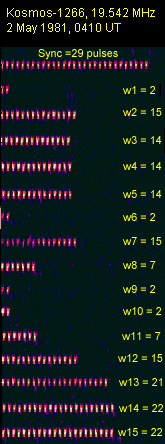 Kosmos-1249 &
Kosmos-1266
Kosmos-1249 &
Kosmos-1266
Kosmos-1249 was launched
from Baikonur at 1809 UT on 5 March 1981 and its companion satellite took off at
0345 UT 21 April 1981. The orbits of the two spacecraft were chosen to be
co-planar with an initial phase difference time separation of 25.9 minutes,
which is close to the theoretical value for co-planar orbits with n=2, i.e. 25.6
minutes. Kosmos-1249 moved to the higher orbit on 19 June 1981 and Kosmos-1266
did the same on 29 April 1981.
Signals were picked up on 166.0 MHz and 19.542 MHz
from both spacecraft. Interestingly, the short-wave telemetry from Kosmos-1266
was not of the normal FSK-PDM type. All telemetry
words in the frame were "pulsed" in the style of the synchronization pulse
train. Instead of try to measure the length of these tones relative to the
synchronization pulse train, it is only necessary to count the number of short
pulses in each word to determine the measured value. The telemetry is
illustrated by the figure on the right which shows each telemetry word below the
one before it. By clicking on the figure the telemetry
signal in the figure can be heard. My radio log shows that the short-wave
telemetry from Kosmos-1266 was of the pulsed type described above, while the
signal from Kosmos-1249 (listen here)
was of the normal FSK-PDM type, but sometimes switching over to the "pulsed"
mode. I was lucky to be able to catch short-wave telemetry from Kosmos-1249 in
the low orbit on 26 April 1981.
Kosmos-1299
Kosmos-1299 was launched
at 1637 UT on 24 August 1981. On 5 September 1981 the reactor was raised
to the high orbit. There is a two-line elements set for a "B" object that is
generated at the time of boost to the high orbit with the epoch day
248.88785098, i.e. at 2118 UT. Therefore the maneuver must have occurred
before this time. There were five pieces generated by the maneuver as shown in
the table on the right. I picked up very strong, but deeply and regularly fading
PPM-AM signals on 166.0 MHz in the evening of 5 September 1981 at
1706.14-1709.05 UT and 2141.55-2147.53 UT. By comparing with passes of the
various pieces it it is obvious that the 166.0 MHz
signals only could have come from the pieces left in low orbit. It is
impossible to determine which one because the reception times match all three
pieces in low orbit. Also, the second reception took place after the first epoch
of object B, so the boost maneuver had indeed taken place. Interestingly during
both receptions the signals was fading deeply indicating that the spacecraft
transmitting the signals was tumbling. Therefore the boost maneuver must have
taken place before my first observation at 1706 UT. I did not hear any more
signals on this frequency from Kosmos-1299. After deactivation of the reactor
the batteries for powering onboard systems in the low orbit object probably
quickly depleted. They were, one can suppose, dimensioned to handle short
interruptions in power from the reactor.
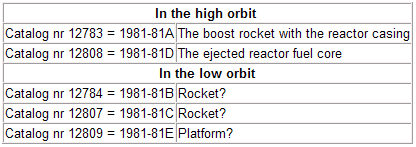 On 6 September
1981 picked up extremely strong short-wave telemetry on 19.542 MHz from
Kosmos-1299 of the pulsed type described above. The signals were received at
1730.45-1738.20 UT and 2103.54-2119.24 UT and were typical of over-the-horizon
receptions. During these receptions object A (cat nr 12783) was always above the
horizon, while object D (cat nr 12808) was well below the horizon at the end of
the second reception. This indicates that the short-wave
transmitter is in the main object in the high orbit, i.e. the boost rocket with
the empty reactor casing. This was confirmed a little more than a year later
during the flight of Kosmos-1402 (see below). Last signals on 19.542 MHz from
Kosmos-1299 were picked up by myself on 13 September 1981.
On 6 September
1981 picked up extremely strong short-wave telemetry on 19.542 MHz from
Kosmos-1299 of the pulsed type described above. The signals were received at
1730.45-1738.20 UT and 2103.54-2119.24 UT and were typical of over-the-horizon
receptions. During these receptions object A (cat nr 12783) was always above the
horizon, while object D (cat nr 12808) was well below the horizon at the end of
the second reception. This indicates that the short-wave
transmitter is in the main object in the high orbit, i.e. the boost rocket with
the empty reactor casing. This was confirmed a little more than a year later
during the flight of Kosmos-1402 (see below). Last signals on 19.542 MHz from
Kosmos-1299 were picked up by myself on 13 September 1981.
The text above is the result of hindsight. At the
time of the US-A flights in 1981 it was not known what the additional piece in
the high orbit (such as 1981-81D) really was. That it was the ejected fuel core
only became evident in connection with the Kosmos-1402 accident. It
is instructive to read what e very knowledgeable analyst such as Nicholas
Johnson wrote at the time (13):
"...A new characteristic of the post-Kosmos-954 radar
satellites was confirmed in 1981. When the nuclear power supply is transferred
to the higher storage orbit, a second fragment is now ejected with a relative
velocity of 6 to 7 meters/sec. Speculation has arisen that this extra piece
may be a potential destruct package. If the spacecraft malfunctions at a low
altitude, the satellite could be blown up, widely scattering its nuclear fuel
and making detection of radioactive debris virtually impossible. If the power
supply reaches the storage orbit, the destruct package is separated to prevent
an accidental explosion and the creation of long-lived
debris..."
This was wrong, but in a
sense not too far off the mark - as we shall see later. Scattering of the fuel
core was the idea of the post-Kosmos-954 series but not in the way thought in
1981.
Kosmos-1365 & Kosmos-1372
Kosmos-1365 was launched from Baikonur at 1939 UT on 14 May
1982 and its companion satellite took off at 1358 UT 1 June 1982. The
orbits of the two spacecraft were chosen to be co-planar with an initial phase
difference time separation of 51.1 minutes, which is close to the theoretical
value for co-planar orbits with n=4, i.e. 51.23 minutes. Kosmos-1365 moved to
the higher orbit on 27 September and Kosmos-1372 did the same on 11 August.
Signals were picked up on 166.0 MHz and 19.542 MHz from both spacecraft. An
examination of my log reveals that the short-wave telemetry from Kosmos-1372 was
of the pulsed type described above, while the signal from Kosmos-1365 was of the
normal FSK-PDM type. So, one may speculate that the two
types of transmissions was a way of discriminating between the two reactor
packages in "storage" orbit.
Kosmos-1402 & Kosmos-1412, another international
incident
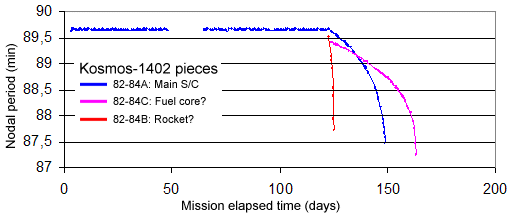 Kosmos-1402 was launched at 1004 UT on 30 August
1982 while Kosmos-1365 was still in operation in the low orbit. Therefore,
another launch was not expected immediately. Kosmos-1402 was launched into an
orbit co-planar with that of Kosmos-1365 and a time phase difference of 38.63
minutes (38.42 minutes is the ideal value for co-planar orbits with n=3). When
Kosmos-1365 was deactivated on 27 September a replacement for that satellite was
promptly launched when Kosmos-1412 was launched at 0000 UT on 2 October 1982.
The orbits of these two spacecraft were chosen to be almost co-planar
(difference 0.85 deg) with an initial phase difference time separation of 25.52
minutes, which is close to the theoretical value for co-planar orbits with n=2,
i.e. 25.6 minutes. However, Kosmos-1412 ended its mission on 10 November 1982
when it moved to the high orbit. Again, despite heroic efforts by Soviet
planners, a single US-A spacecraft was left in the operational orbit.
Kosmos-1402 "soldiered on" in this orbit until the end of December 1982 when
dramatic events occurred. The graph below shows how the spacecraft was split
into three pieces that all decayed instead of moving to the high
orbit.
Kosmos-1402 was launched at 1004 UT on 30 August
1982 while Kosmos-1365 was still in operation in the low orbit. Therefore,
another launch was not expected immediately. Kosmos-1402 was launched into an
orbit co-planar with that of Kosmos-1365 and a time phase difference of 38.63
minutes (38.42 minutes is the ideal value for co-planar orbits with n=3). When
Kosmos-1365 was deactivated on 27 September a replacement for that satellite was
promptly launched when Kosmos-1412 was launched at 0000 UT on 2 October 1982.
The orbits of these two spacecraft were chosen to be almost co-planar
(difference 0.85 deg) with an initial phase difference time separation of 25.52
minutes, which is close to the theoretical value for co-planar orbits with n=2,
i.e. 25.6 minutes. However, Kosmos-1412 ended its mission on 10 November 1982
when it moved to the high orbit. Again, despite heroic efforts by Soviet
planners, a single US-A spacecraft was left in the operational orbit.
Kosmos-1402 "soldiered on" in this orbit until the end of December 1982 when
dramatic events occurred. The graph below shows how the spacecraft was split
into three pieces that all decayed instead of moving to the high
orbit.
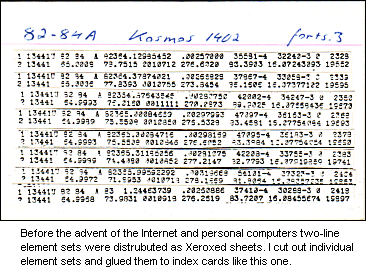 By analyzing the
relative motion of these pieces it seems that the C object, presumably the fuel
core as we shall see later, seems to have separated at high speed (<10 m/s?)
from the main A object late (approx. 2200 UT) on 27 December 1982. A sign of
this can be seen in the graph above; the fuel core orbital period trace starts
at 89.4 minutes - well below the orbital period curve for the main object. The B
object, often called the rocket separated from the main object at about 0200 UT
on 28 December 1982. The last element set of Kosmos-1402 which shows an increase
of period relative to an earlier value is dated at 2250 UT on 27 December 1982.
So, it seems that in the hours around midnight of 27/28 December the last
orbit-correction maneuver was made, controllers realized that the spacecraft was
malfunctioning and the attempt to boost it to higher orbit took place, but
failed. However, the relative motion analysis appears strange. One would have
thought that the low-density "rocket" would have separated from the vehicle
before the fuel core. The main object would have ascended to high orbit and then
discarded the fuel core. Here, events seem reversed. It should be remembered
that the relative motion analysis is uncertain. It is based on single element
sets that could have errors in them.
By analyzing the
relative motion of these pieces it seems that the C object, presumably the fuel
core as we shall see later, seems to have separated at high speed (<10 m/s?)
from the main A object late (approx. 2200 UT) on 27 December 1982. A sign of
this can be seen in the graph above; the fuel core orbital period trace starts
at 89.4 minutes - well below the orbital period curve for the main object. The B
object, often called the rocket separated from the main object at about 0200 UT
on 28 December 1982. The last element set of Kosmos-1402 which shows an increase
of period relative to an earlier value is dated at 2250 UT on 27 December 1982.
So, it seems that in the hours around midnight of 27/28 December the last
orbit-correction maneuver was made, controllers realized that the spacecraft was
malfunctioning and the attempt to boost it to higher orbit took place, but
failed. However, the relative motion analysis appears strange. One would have
thought that the low-density "rocket" would have separated from the vehicle
before the fuel core. The main object would have ascended to high orbit and then
discarded the fuel core. Here, events seem reversed. It should be remembered
that the relative motion analysis is uncertain. It is based on single element
sets that could have errors in them.
It took a few days for the news about the
misfortune of Kosmos-1402 to reach the Kettering Group and to trickle into the
open domain. Geoff Perry, the senior science master at Kettering Boys' School
and leader of the Kettering Group had assigned orbital analysis of Kosmos-1402
to one of his pupils. John Corvesor plotted orbital period vs time and used
Xeroxed copies of two-line elements sets printout mailed from NASA's
Goddard Space Flight Center. I used the same source myself and we usually got
the envelopes at the same time, about five days after they were mailed in the
U.S. a couple of times per week (incredibly, this was a free service).
Therefore, there was an inevitable time lag in monitoring the status of
Kosmos-1402. When Geoff Perry was called by a U.S. journalist on 3 January 1982
about a possible mishap to Kosmos-1402 he could only say that as of 26 December
everything was OK. During this period, two-line element sets were received in
the U.K. by telex at Aston University and on 4 January, without giving Geoff
Perry any orbital data, they told him that Kosmos-1402 had split into three
pieces. Geoff called me the following morning (5 Jan) to see if I had had a
later mailing from GSFC of elements - and indeed - I had. I had processed (cut
and glued) the element sets. In the wastepaper basket I found the element sets
for the two new objects, B and C as well as for A. The data showed that the two
new objects had appeared early on 28 December, but that there was an
element set for the A object in the low orbit for early on 29 December. So, the
ascent to the high orbit had indeed failed. So, there was another major
international incident in the works. On 5 January I also informed Geoff that
space tracker Jan-Ola Dahlberg in Malmö had picked up short-wave signals on
19.542 MHz typical of US-A satellites on 30 December. Based on the element sets
I gave him and Jan-Ola's signals Geoff Perry gave the news for publication by
ITN at 1435 UT on 5 January 1982.
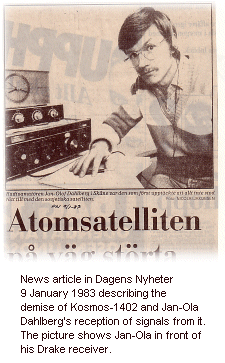 On 6 January Soviet
media denied that anything was amiss with Kosmos-1402 "on a pre-planned course
and presented no danger" , but the following day they did admit the the
satellite was coming down. At 1700 MT the following statement was issued
by Moscow:
On 6 January Soviet
media denied that anything was amiss with Kosmos-1402 "on a pre-planned course
and presented no danger" , but the following day they did admit the the
satellite was coming down. At 1700 MT the following statement was issued
by Moscow:
"... On Dec 28 the satellite's active mission ended and
in accordance with the flight programme it separated into individual fragments
upon command from the ground. The purpose of this was to isolate the active
part of the reactor so that it would burn in the dense layers of the
atmosphere, the radioactivity levels following this remain within the limits
of the natural background..."
At
the time of this hidden high drama the Kettering Group was trying to find
signals from a new type of spacecraft, Kosmos-1426, and we were listening on all
known frequency bands. Jan-Ola Dahlberg in Malmö in southernmost Sweden then
happened to pick up signals on 19.542 MHz, the typical US-A frequency. He picked
up the "pulsed" mode telemetry with the characteristic telemetry words 1, 6 and
9 short. The first brief observation was made on 29 December at 1755.57-1756.14
UT when all Kosmos-1402 pieces were far to the east of Sweden. Two more such
observations were made on 31 December 1149.00-1154.30 UT and at 1223.12-1228.00
UT.
However, a most important observation with very
strong signals indicating that the spacecraft was over the horizon was made on
30 December at 0631.30-0638.00 UT. This made it possible to determine the origin
of these signals. The map below shows that the main piece of Kosmos-1402,
82-84A, was above the horizon when the signals were heard. The "B" piece had
passed Malmö ten minutes earlier and the reactor core "C" had passed 20 minutes
early so neither of these could be the source of the signals (7). Because we suspected that the
short-wave transmitter was in the rocket stage that brought the reactor and its
fuel core to the high orbit (see Kosmos-1299 above), Jan-Ola's signals also confirmed the misfortune of
Kosmos-1402. After we had learned about the misfortunes of Kosmos-1402 in
early January we tried pick up more signals on 19.542 MHz from Kosmos-1402, but
to no avail. Jan-Ola's signals on 31 December were the last from this
spacecraft.
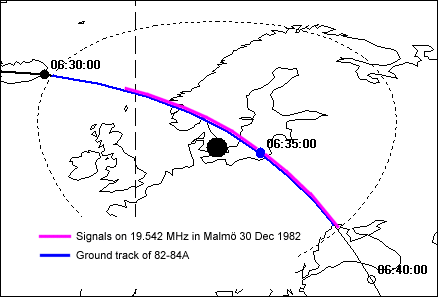 The next phase of the
public excitement around the Kosmos-1402 mishap was the estimate of the re-entry
time. Orbital data were still scarce so people with only public domain
information were "fumbling in the darkness". On 10 January doubts as to what the
A and C parts were started to appear. Pierre Nierinck, a very skilled satellite
observer and orbital analyst based in Dunkirk, had calculated that the densities
of the A, B and C objects were related as B,A,C=1,10.2,24.5 showing that C was
the most dense objects. Pierre also calculated that the re-entries of the A and
C objects would be Jan 23 +/- 4 days for the A object and Feb. 7 +/7 days for
the C object (8). This agreed well with the date January
22.82 calculated by Geoff Perry using a method developed by King-Hele (9). On 15 January I called Geoff Perry at
0911-0926 UT and argued that the A piece was coming down faster than it should
have in case the reactor was attached. I argued that we were concentrating on
the wrong object if we wanted to follow the fate of the reactor. Geoff tried to
convince me that there always was an object that flew for 20-30 days after
separation of all the object. In my diary I can read "I am still skeptical" (10). At 1656 UT Geoff Perry was called by a
newspaper ("The Mail on Sunday") who told him that TASS announced that the
reactor fuel core would burn up in mid-February. At that moment it was clear
that we had been worrying about the wrong object.
The next phase of the
public excitement around the Kosmos-1402 mishap was the estimate of the re-entry
time. Orbital data were still scarce so people with only public domain
information were "fumbling in the darkness". On 10 January doubts as to what the
A and C parts were started to appear. Pierre Nierinck, a very skilled satellite
observer and orbital analyst based in Dunkirk, had calculated that the densities
of the A, B and C objects were related as B,A,C=1,10.2,24.5 showing that C was
the most dense objects. Pierre also calculated that the re-entries of the A and
C objects would be Jan 23 +/- 4 days for the A object and Feb. 7 +/7 days for
the C object (8). This agreed well with the date January
22.82 calculated by Geoff Perry using a method developed by King-Hele (9). On 15 January I called Geoff Perry at
0911-0926 UT and argued that the A piece was coming down faster than it should
have in case the reactor was attached. I argued that we were concentrating on
the wrong object if we wanted to follow the fate of the reactor. Geoff tried to
convince me that there always was an object that flew for 20-30 days after
separation of all the object. In my diary I can read "I am still skeptical" (10). At 1656 UT Geoff Perry was called by a
newspaper ("The Mail on Sunday") who told him that TASS announced that the
reactor fuel core would burn up in mid-February. At that moment it was clear
that we had been worrying about the wrong object.
The TASS announcement quoted a Dr Belotserkovskiy
of the Academy of Sciences. He explained that the fuel core would disperse in
the atmosphere and that radioactivity would be well below the natural
background. While this was reassuring, it did not calm anyone, and the A object
would still contain radiation contaminated material. So, the hunch of Pierre
Neirinck to analyze densities showed clearly that the densest object "C" must
have been the fuel core. Pierre at that point had recalculated the densities as
B,A,C=1,9.23, 19.01. We continued to compute the re-entry date by fitting a
second degree curve by the least squares method to find the decay rate (n-dot).
This was used in the method (9) developed by King-Hele
to compute the decay date. The graph shown here displays how the predicted decay
date converged nicely to the actual decay date - naturally. The prediction
always underpredicted the lifetime of the spacecraft. Not much, but still we
always underestimated the lifetime, initially by approximately 7%.
The A piece, the boost rocket and reactor hull
entered the Earth's atmosphere at 2210 UT and possibly reached the surface at
2222 UT on 23 January. This corresponds to the epoch 23.92. The reactor core
entered the Earth's atmosphere at 1056 UT according to Soviet data and
fragments, if any would have reached the earth's surface at 1107 UT according to
US sources.
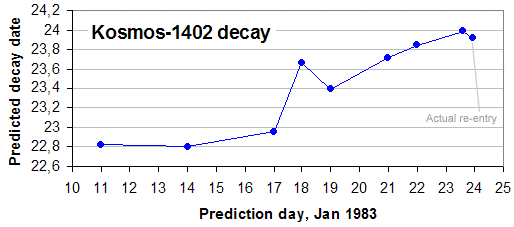 The fact that the
reactor fuel core had been separated and that this new safety device had been
introduced to handle situation such as the earlier accident with Kosmos-954 was
not really known until the Soviet authorities said so in connection with
Kosmos-1402. Earlier evidence that an additional object appeared in the high
orbit after Kosmos-954 had not been interpreted as ejection of the fuel core.
The confusion in connection with Kosmos-1402 also showed that Western
intelligence sources had not correctly understood the redesign of the US-A
system at this time. In a UN document from 1980
(12) there are hints at this method. The document discusses what happens
if the structural parts holding the fuel rods melt during re-entry. The
radioactive material is then dispersed so that no change in the background
radiation can be expected. But the document does not mention intentional
ejection of the fuel core - only hints at the existence of a back-up safety
system. Evidently, the Soviet authorities also used the ejection of the fuel
core as a means of countering the other criticism of the US-A system; that the
ascent t the high orbit only postponed the radioactive contamination problem.
With the fuel core ejected even in the high orbit, Soviet authorities could
argue that when that reentered in a thousand years' time it too would
"disappear" in the natural background radiation. In effect the revised design of
the US-A system meant that the previous design was ruled as totally unsafe. Let
me quote Nicholas Johnson's interesting remarks in (11):
The fact that the
reactor fuel core had been separated and that this new safety device had been
introduced to handle situation such as the earlier accident with Kosmos-954 was
not really known until the Soviet authorities said so in connection with
Kosmos-1402. Earlier evidence that an additional object appeared in the high
orbit after Kosmos-954 had not been interpreted as ejection of the fuel core.
The confusion in connection with Kosmos-1402 also showed that Western
intelligence sources had not correctly understood the redesign of the US-A
system at this time. In a UN document from 1980
(12) there are hints at this method. The document discusses what happens
if the structural parts holding the fuel rods melt during re-entry. The
radioactive material is then dispersed so that no change in the background
radiation can be expected. But the document does not mention intentional
ejection of the fuel core - only hints at the existence of a back-up safety
system. Evidently, the Soviet authorities also used the ejection of the fuel
core as a means of countering the other criticism of the US-A system; that the
ascent t the high orbit only postponed the radioactive contamination problem.
With the fuel core ejected even in the high orbit, Soviet authorities could
argue that when that reentered in a thousand years' time it too would
"disappear" in the natural background radiation. In effect the revised design of
the US-A system meant that the previous design was ruled as totally unsafe. Let
me quote Nicholas Johnson's interesting remarks in (11):
"... The solution
finally chosen by the Soviets say as much about their philosophy of spacecraft
design as it does their space technology. Instead of incorporating additional
redundant features into the propulsion mechanism that failed, the Soviets
concluded that no system was perfectly fail-safe and therefore they concentrated
on methods to prevent detectable radioactive debris from striking the earth. In
the case of Kosmos 954, it was the rugged reactor housing that protected the
'hot' fuel core during reentry and contributed to the contamination of the
canadian tundra. The final Soviet solution was to develop a way to eject the
fuel core from the reactor. This technically challenging operation would ensure
incineration of the unprotected fuel core during reentry. The remaining reactor
housing, which still possessed a lower radiation level, would also be likely to
undergo more complete burnup and fragmentation as it reentered the Earth's
atmosphere..."
Thus ended the second serious mishap in the US-A
series. There would almost be one more before the program ended in connection
with the break-up of Soviet power.
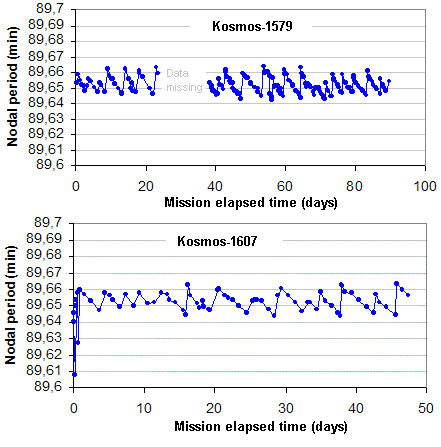 Kosmos-1579 and Kosmos-1697, two single spacecraft
missions
Kosmos-1579 and Kosmos-1697, two single spacecraft
missions
The US-A program resumed at 0021 UT on 29 June 1984
when Kosmos-1579 was launched . There was a big naval exercise in the Baltic at
the time of its launch, but it is unclear if this was significant. the
spacecraft remained in operation in the low orbit until 27 September 1984,
i.e. 90 days. The orbit maintenance of Kosmos-1579 was very regular as shown by
the plot of orbital altitude vs time. Orbit corrections were performed
approximately every three to four days.
There was no second US-A satellite launched to work
with Kosmos-1579. Instead , Kosmos-1579 probably operated in unison with the
US-P spacecraft Kosmos-1567. Evidence of this is the typical spacing between the
orbital planes of the two spacecraft of approximately 150 degrees. Geoff Perry
and I tracked the spacecraft in July 1984 while Geoff was a house guest of
myself and my wife Inger on his way to a conference in Sweden. We heard the
166.0 MHz telemetry at 0721-0726 UT on 8 July 1984.
Kosmos-1607 was launched at 1229 UT on 31 October
1984. I picked up signals on 166.0 MHz on eight occasions between 10 November
1984 and 27 January 1985. The spacecraft moved to the higher orbit on 1 February
1985 after 90 days. This spacecraft was also co-ordinated with the orbital plane
of the US-P spacecraft Kosmos-1579 and -1588. In the figure on the right orbital
data are only available for half of the low orbit phase.
Kosmos-1670 & Kosmos-1677, the last dual
spacecraft mission
Kosmos-1670 (catalog
number 15930) was launched at 0536 UT on 1 August 1985.
Kosmos-1677 (catalog number 15986) was launched at 2233 UT on 23
August 1985. The orbits of the two spacecraft were almost exactly co-planar with
an initial phase difference time separation of 25.6 minutes, which is the
theoretical value for co-planar orbits with n=2. Kosmos-1670 was raised to the
high orbit on 22 October 1985 and Kosmos-1677 performed the same maneuver on 23
October 1985. Initially the two US-A spacecraft operated in coordination with
the two US-P spacecraft Kosmos-1567/1646 as shown by the 150 degrees of angular
distance between the orbital planes of the two pairs of spacecraft. A third US-P
spacecraft was launched on 19 September 1985 to take up its place in the US-P
system. Five Soviet ocean surveillance satellites operated at the same time (22)!
The timing of the launches seems to have been
connected to NATO's largest peacetime naval exercise "Ocean Safari 85" in which
some 200 warships from 10 countries participated. Aircraft carriers and the U.S.
battleship Iowa took part. Soon after the launch of Kosmos-1677, ships started
to leave Norfolk, Virginia, for the rendezvous area off Boston. The "armada"
then sailed to Iceland and onwards to Europe to simulate the resupply of Europe
in case of war. Mock attacks against the convoy were conducted. The maneuvers
continued in the North sea, the Straits of Denmark and the Baltic (22). This must have been a very tempting target
for the US-A system. It is therefore understandable that a dual spacecraft
mission was flown. As it turned out, because of the ascent of Mikhail Gorbachev,
reduced East-West tension and the eventual fall of the Soviet Union, this was
the last dual spacecraft US-A mission.
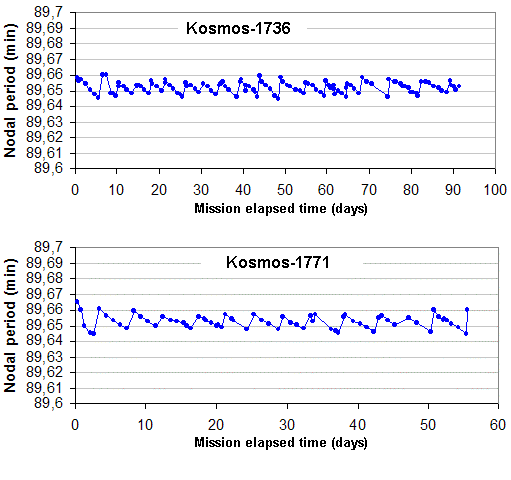 Kosmos-1736
Kosmos-1736
Kosmos-1736 (catalog number 16647) was launched at 1005 UT
on 21 March 1986. It moved to the higher orbit on 20 June 1986 after 92 days.
Kosmos-1736 entered orbit in a plane 137 degrees (well within the 132-150 degree
band established since 1975) from that of Kosmos-1735, a US-P spacecraft (23). Johnson (23) also
speculated that the timing of the launch had something to do with U.S. naval
maneuvers off Libya a few days later.
Kosmos-1771
Kosmos-1771 (catalog
number 16917) was launched at 1258 UT on 20 August 1986. Again the spacecraft's
orbital plane was 150 degrees away in right ascension from that of Kosmos-1735.
Thus, it seems that the new US-A satellite was working in conjunction with the
same US-P spacecraft as its predecessor. A U.S. armada of some 30 ships,
including two aircraft carriers and a battleship, performed maneuvers in
the Sea of Japan and the Sea of Okhotsk during September and into early October
1986 (23). As the U.S. naval operation ended two
Soviet ocean surveillance satellites, Kosmos-1682 and -1771 were taken out of
operation. Kosmos-1771 boosted itself to the high orbit on 15 October
1986.
Kosmos-1818
At 2330 UT on 1 February
1987 a US-A satellite, Kosmos-1818, (catalog number 17369) was launched into an
unusual orbit signaling something entirely new in the program. It was put into
an orbit at 65 degrees inclination between 789 and 802 km altitude. It seems
that the main US-A spacecraft bus was used to insert the spacecraft into the
high orbit. In that orbit two large fragments were detached.
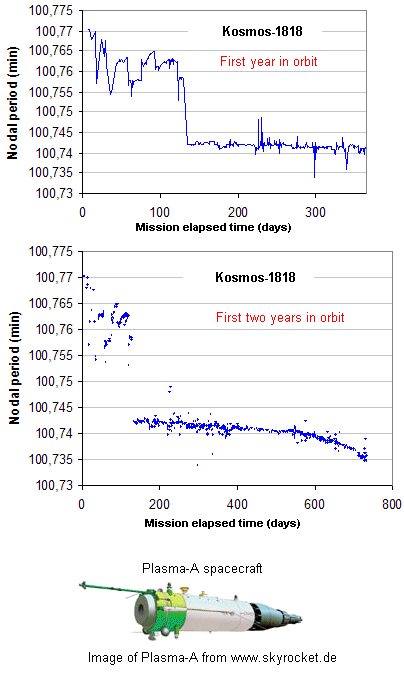 Although not revealed
immediately, it later turned out that this spacecraft was called Plazma-A and
tested the new TEU-5 Topol (1) reactor, ion engines and
other systems (27). Sketches of
this spacecraft do not show a radar such as on the original system. Perhaps the
radar antenna would appear on later operational models of this spacecraft type.
But perhaps the higher output of the new reactor type would have made it
possible to operate the radar from the higher altitude. The higher altitude
would also make it unnecessary to make a maneuver up to a higher orbit to store
the deactivated reactor.
Although not revealed
immediately, it later turned out that this spacecraft was called Plazma-A and
tested the new TEU-5 Topol (1) reactor, ion engines and
other systems (27). Sketches of
this spacecraft do not show a radar such as on the original system. Perhaps the
radar antenna would appear on later operational models of this spacecraft type.
But perhaps the higher output of the new reactor type would have made it
possible to operate the radar from the higher altitude. The higher altitude
would also make it unnecessary to make a maneuver up to a higher orbit to store
the deactivated reactor.
Kosmos-1818 was placed in an orbit that repeated
its ground track every 99 revolutions. Repeating ground track patterns are
described in a separate article. The parameters used to describe the
orbit of Kosmos-1818 are N,M,Q=14,1,7. The resulting orbit has an average
altitude above a spherical earth of 792.9 km and a nodal period of 100.76
minutes. As shown in the top graph on the right the spacecraft maintained this
period for about 130 days. It then maneuvered down to an orbit with a period of
100.74 minutes after which it started to gradually lower its orbit. (The
"spikes" in the orbital period graph are probably artifacts). The lower figure
on the right is suggestive of natural decay, but thus is not altogether clear.
Up until 400 days mission elapsed time there were variations in period that
could be the result of maneuvers. During the period of orbit control near 100.76
minutes there were episodes of monotonic increase of the period indicating the
use of ion thrusters. Nothing similar had been seen since Kosmos-723 in April
1975.
Actually, making a maneuver down from the repeating
pattern orbit makes sense if the spacecraft had been deactivated upon leaving
the 100.76 minute level. If left at the higher altitude to decay naturally, it
would pose a collision risk, albeit small, for later replacement
satellites.
According to Günther
Krebs' web site
"... The Plazma-A
satellites were technological test spacecraft to test out new systems for the
US-AM RORSATs. It was based on the US-A RORSAT bus, but was fitted with the new
Topaz nuclear rector, which used thermo-emission conversion method to convert
heat to electricity. Topaz provided over 10 kW of power and had long endurance
and storage in a radiation-safe orbit. Plasma-A did not have the radar of the
US-A spacecraft, but tested a number of other systems: electrostatic manoeuvring
engines, ion orientation and stabilization engines, solar sensors, magnetic
momentum compensators, and multi-channel wave devices. The Plasma-A satellites
carried instruments to map the magnetic field of the earth for the development
of a magnetic navigation system ..."
Kosmos-1860, the last US-A spacecraft tracked by the
Kettering Group
Kosmos-1860 (Catalog nr
18122) was launched at 2133 UT on 18 June 1987. I picked up my first
signals from this spacecraft (on 166.0 MHz) on 23 June 1987 and heard it a
total of five times before I "dropped track of it" on 26 June 1987. That was the
last the Kettering Group ever heard of this type of satellite. The orbital plane
of Kosmos-1860 was 142 degrees from that of the US-P spacecraft Kosmos-1834 (25). It seemed that this US-A spacecraft,
Kosmos-1860, was launched at a time of some increased tension, just as previous
such mission had. In this case the Soviet Union had recently accused the US navy
of violation of Soviet territorial waters. Also the U.S. was making a strong
naval buildup in the Persian Gulf after the attack on the U.S.S. Stark on 17 May
(25). The spacecraft operated in low orbit until
28 July when the boost to the high orbit occurred. The life in low orbit was 40
days and the spacecraft displayed very normal behavior in low orbit with orbit
adjustments approximately every five days..
Kosmos-1867, another gamma-ray
pollutant
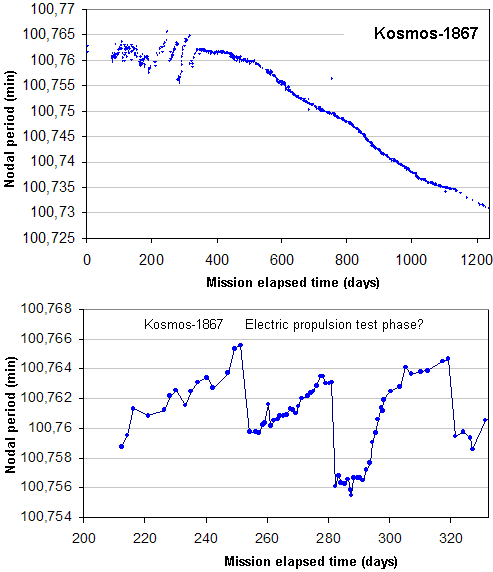 The second Plasma-A test
satellite, Kosmos-1867, was launched at 1535 UT on 10 July 1987. It initially
repeated the flight pattern of Kosmos-1818 and entered the 100.76 min repeating
pattern orbit. The period was maintained near 100.76 minutes for about 520 days.
Initially, there were large excursions of the orbital period around 100.76
minutes. During these excursions the period sometimes increased monotonically,
indicating continuous thrust by an electric rocket motor. Later the orbit was
maintain at rather steady values. During this later phase it seemed as if the
electric thruster (Plasma-2 SPT electric engine) was switched on and off. After
the 520 days of controlled orbit the natural decay started.
The second Plasma-A test
satellite, Kosmos-1867, was launched at 1535 UT on 10 July 1987. It initially
repeated the flight pattern of Kosmos-1818 and entered the 100.76 min repeating
pattern orbit. The period was maintained near 100.76 minutes for about 520 days.
Initially, there were large excursions of the orbital period around 100.76
minutes. During these excursions the period sometimes increased monotonically,
indicating continuous thrust by an electric rocket motor. Later the orbit was
maintain at rather steady values. During this later phase it seemed as if the
electric thruster (Plasma-2 SPT electric engine) was switched on and off. After
the 520 days of controlled orbit the natural decay started.
At the time of this flight observers were indeed
confused as to the character of the satellite. However, the era of Glasnost had commenced and the true character of the
Kosmos-1818 and Kosmos-1867 missions was revealed by the Soviet Union at the 6th
Symposium on Space Nuclear Power Systems held in Albuquerque, New Mexico, during
8-12 January 1989 (28). At that symposium it was revealed
that the spacecraft had carried a 10 KW reactor with a thermionic system for
conversion of the reactor's power into electric energy. The operation of the
reactor in high orbit had also caused interference with scientific space
missions such as the Solar Maximum Mission (SMM). It seems that the problem was
detected back in 1980 but escalated in February 1987 when Kosmos-1818 put a live
reactor for a long period above the altitude of SMM (26). As
Allen Thomson explained in a letter to the FPSPACE listserver on 29 March 2004:
"... The interference
problems mostly or entirely came from the injection of positrons into the
magnetosphere while reactors were operating (gamma rays from the fission
reaction interacted with reactor and adjacent material to produce
electron-positron pairs, the electrons and positrons were then trapped in flux
tubes in the magnetosphere, and when the positrons encountered another satellite
they annihilated with electrons in the structure to produce gamma
rays). There may have been some direct interference when other satellites
got close to the operating reactors, but those instances would have been fairly
brief and infrequent. As noted, the RORSATs were too low during their
operational lifetime to contribute much to the trapped-positron problem.
It was only the two Topaz reactors which operated at a considerably higher
altitude that managed to make a nuisance of themselves by interfering with
instruments on Solar Max and Ginga (and possibly other satellites)
..."
Kosmos-1900 & 1932, a confusing
finale
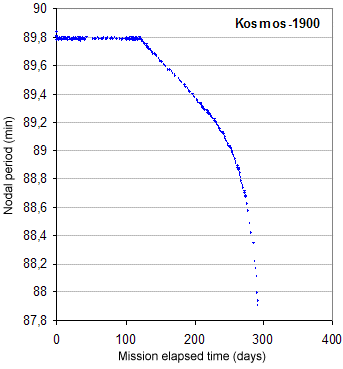 Kosmos-1900 (Catalog
number 18665) was launched at 0540 UT on 12 December 1987. The parameters used
to describe the orbit of Kosmos-1900 are N,M,Q=16,-1,6, which means that the
ground track repeats every 95 revolutions. The resulting orbit has an average
altitude above a spherical earth of 262.1 km and a nodal period of 89.79
minutes.
Kosmos-1900 (Catalog
number 18665) was launched at 0540 UT on 12 December 1987. The parameters used
to describe the orbit of Kosmos-1900 are N,M,Q=16,-1,6, which means that the
ground track repeats every 95 revolutions. The resulting orbit has an average
altitude above a spherical earth of 262.1 km and a nodal period of 89.79
minutes.
Another US-A spacecraft, Kosmos-1932, was launched
at 1421 UT on 14 March 1988. Strangely enough this satellite used the older,
traditional orbit with a 7-day, 111 revolution, repeating ground track
pattern.
The Kosmos-1900 spacecraft maintained this tightly
controlled orbit until mid-April 1988. On 10 April the last orbit correction
occurred. After that a steady decay started. Initially it was thought that the
spacecraft would descend to the 89.6 minute orbit with a 7-day, 111 revolution,
repeating pattern. That altitude was reached on 9 May 1988 and when the
spacecraft continued to drop it was obvious that the spacecraft was in
trouble.
The news spread forcing TASS on 13 May 1988 to
announce that contact with the craft was lost in April, but that there was no
danger to the general public because there were "systems ensuring radiation
safety on completion of the flight". While this bad news spread Kosmos-1932
terminated its mission and safely boosted its reactor to the high orbit (See
below). However, international concern over the flight prompted TASS to give
more details about the reactor. In a report to the International Atomic Energy
Agency the total mass of radioactive fuel (90% U-235 and the rest U-238) with
six beryllium reflector rods measuring 100x250 millimeters and weighing 3.6 kg.
The report described the safety features. The boost to the high orbit would be
triggered by:
- Command
- Loss of spacecraft pressurization
- Reactor power deviations
- Loss of attitude control
In addition there was a back-up system to triggered at
115-120 km by aerodynamic heating at which occurrence the reactor core would be
ejected.
Meanwhile, on 20 May 1988, Kosmos-1832 boosted
itself to the high orbit after 66 days. The flight had proceeded in a perfectly
normal way with maneuvers every 3-4 days.
On 24 September 1988 Moscow television admitted
that the mission of Kosmos-1900 had been to "observe ocean surfaces". Perhaps
this admission could be made at this time because the decision to cancel the
program had been taken or was imminent.
However, all through the natural decay of the craft
its attitude control seems to have been working well. However in the evening
hours the spacecraft lost stabilization - due to aerodynamic forces or loss of
attitude control propellant - is not known. Also, electric power must have been
generated throughout this long period - and the only available source of power
was the reactor. It must have performed reasonably well since it did not trigger
the ascent to high orbit. But the loss of attitude control immediately triggered
the boost to higher orbit - at 2108 UT on 30 September 1988, according to TASS.
However, the resulting high orbit was somewhat different from normal, possibly
caused by an incorrect initial attitude at separation of the ascent vehicle. If
the maneuver started at the equator the yaw error could have been as much as 45
degrees causing a lower apogee of the transfer orbit. The final orbit was about
300 km lower than normal; actually between 695.4 km and 763.4 km at 66.1 degree
inclination. So, the improbable happened, at the last moment the safety system
actually worked and propelled the Kosmos-1900 reactor into high orbit. TASS
could not resist issuing a triumphant message on 17 October 1988. The news
agency had earlier reported both the ascent to high orbit and the decay of the
main spacecraft left in low orbit which re-entered over the indian Ocean at 2226
UT on 1 October 1988.
So, Kosmos-1932 was the last launch of the US-A
program, while Kosmos-1900 was the last US-A craft to "leave the
stage".
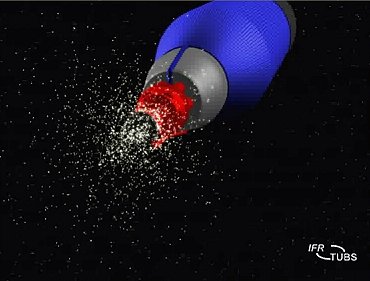 The final chapter - Sodium/Potassium coolant from
US-A satellites found in orbit
The final chapter - Sodium/Potassium coolant from
US-A satellites found in orbit
As we have seen there
was a significant design change to the US-A satellite after the Kosmos-954
accident. At the conclusion of primary mission at low altitude, the nuclear
reactor section was boosted up to an 800-900 km graveyard orbit - as before the
Cosmos 954 accident - but with the important difference that the fuel core was
there ejected in any case. The fuel core separation was accompanied by a loss of
sealing in the primary reactor coolant loop, containing 13 kg of liquid NaK.
Therefore, a leakage of NaK droplets occurred. The secondary reactor coolant
loop, with 26 kg of liquid NaK, was designed to maintain, instead, its sealing.
The figure on the right shows a computer-generated view of the reactor core
ejection and droplet dispersion. This image has been captured from a movie clip
gracefully provided by Carsten Wiedemann of the Institute of Aerospace Systems
at the Technical University of Braunschweig. A German report to the U.N.
summarized the situation (30):
"... the so-called
RORSAT droplets, were found in the course of sample measurements with Haystack
radar. It detected a large swarm of objects in near circular, 65o inclined orbits at an altitude of about 900 km. A
more detailed examination of those objects, using the Millstone Hill and
Goldstone radar sites as well as optical observations, showed that they were up
to 5.6 cm in diameter, of spherical shape and exhibiting characteristics of
specular metals. From decay measurements, a consistency of about 900
kg/m3could be
derived. All these facts point in the direction of liquid sodium-potassium (NaK)
droplets exhausted from the nuclear reactors of Russian RORSAT satellites that
used NaK as a coolant.
Those satellites, which
are not in use any more, are dumped in a 950 km storage orbit, where the later
version of RORSATs release their fuel rods from the reactor core to ensure
complete disintegration during later re-entry. Probably, in the course of this
procedure, a large fraction of the NaK coolant is ejected into space. Effects
like cavitational bursting within the outflowing stream may result in the
generation of an appreciable number of even small droplets. Due to very low
evaporation rates, the thus generated droplets form metallic spheres that remain
nearly unchanged in size for their orbital lifetime.
The problem here is
similar to that posed for the modeling of orbital fragmentations: only the upper
end of the diameter spectrum can be made subject to verification by direct
measurement. Therefore, any mass or diameter distribution derived from a
theoretical modeling of the outflow process suffers from a large margin of
uncertainty—especially in this case, where nearly no data on the smaller end of
the size spectrum are available.
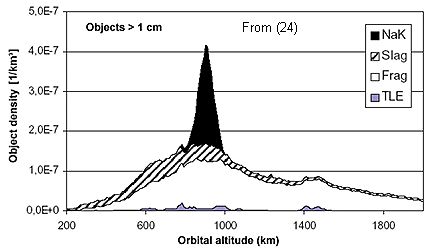 Material data for NaK
usually is only given for parameter intervals being of some interest for
thermodynamic processes, and experiments to examine the effect of liquids
spraying into a vacuum have so far only been conducted for water. However, some
similarities between water and NaK, especially in terms of consistency, together
with the general lack of data, seem to justify adopting at least the basic
characteristics of the water droplet diameter distribution data for the NaK
problem. This assumption is also supported by the fact that the vapour pressure
of hot NaK (753 K) equals that of water at room temperature (293 K) ..." (30).
Material data for NaK
usually is only given for parameter intervals being of some interest for
thermodynamic processes, and experiments to examine the effect of liquids
spraying into a vacuum have so far only been conducted for water. However, some
similarities between water and NaK, especially in terms of consistency, together
with the general lack of data, seem to justify adopting at least the basic
characteristics of the water droplet diameter distribution data for the NaK
problem. This assumption is also supported by the fact that the vapour pressure
of hot NaK (753 K) equals that of water at room temperature (293 K) ..." (30).
Carsten Wiedemann writes in his summary (24) of the US-A orbital debris problem that
about 2/3 of the 13 kg NaK in the primary cooling loop was ejected at an average
speed of 13 m/s. Modeling of the resulting debris population assumed an
omnidirectional spreading of the NaK droplets. The coolant is an eutectic alloy
of sodium and Potassium with 77.8% (by weight) of potassium. This alloy is
called NaK-78. the total mass of NaK ejected by 16 US-A spacecraft was 146 kg,
but progressive decay and evaporation caused the maximum amount of NaK droplets
in orbit to reach 110 kg at the time of the raising to high orbit of
Kosmos-1900. In 1999 this amount had dropped to about 55 kg. Initially, even
very small droplets were present. In fact in terms of numbers small droplets
dominated. The maximum size of the population was estimated to be about 5 cm.
Small particles have a higher drag because the surface to volume ratio is higher
than for larger droplets. Therefore, in 1999, there were probably no droplets
left with sizes less than 3 mm. The total number of droplets was initially more
than half a million, while the corresponding number in 1999 probably was about
half that number. The space debris population in general is dominated by small
particles, but for objects larger than 1 cm the NaK droplets are a significant
contributor to the space debris density between 800 and 1000 km.
Acknowledgments and concluding note
The
author gratefully acknowledges the assistance of Carsten Wiedemann of the
Institute of Aerospace Systems at the Technical University of Braunschweig for
providing much material for this article, including a big package of articles
about the RORSAT program including references 33-40.
Much material has also been obtained from Mark
Wade's www.astronautix.com - a prime source of astronautics
history on the Internet - which is herewith acknowledged.
This article is a continuing project. There is much
more to tell about this fascinating program and so many aspects not yet covered
by the text above. Stay tuned!
References
- Siddiqi, Asif, Staring at the
Sea: The Soviet RORSAT and EORSAT Programmes, JBIS, Vol. 52, No. 11/12.
Nov/Dec 1999, pp.397-416.
- Perry, Geoff, Russian Ocean
Surveillance Satellites, The Royal Air Forces Quarterly, Vol 18, Spring 1978.
pp. 60-67
- Perry, Geoff, "day-to-day
log", entry for 13 April 1975.
- Encyclopaedia Astronautica.
- Weiss, Gus 'The Life and Death of Cosmos
954", Studies in Intelligence, Spring, 1978.
- Johnson, Nicholas L.,
"Orbital Phasings of Soviet Ocean Surveillance Satellites", Journal of
Spacecraft and Rockets.Vol. 19. No. 2, March-April 1982, pp.
113-117
- Internal Swedish Space Corporation memo A22/1-2 (in
Swedish), dated 18 January 1983, written by myself and entitled "In which
parts are the RORSAT transmitters?"
- Perry, Geoff, "day-to-day
log", entry for 10 January 1983.
- D.G. King-Hele, JBIS, 31, pp.
181-196 (1978)
- Sven Grahn, personal diary,
entry for 15 January 1983.
- Johnson, Nicholas L.,
"The Soviet year in Space 1983", Teledyne Brown Engineering,
1984.
- UN Committee on the Peaceful uses of Outer Space document
A/AC.105/C.1/WG.V/L.10, "Studies on technical aspects and safety measures of
nuclear power sources in outer space", January 1980
- Johnson, Nicholas L., "The
Soviet year in Space 1981", Teledyne Brown Engineering, 1982.
- Radio Sweden domestic service, news broadcast on 2 May
1980.
- Perry, Geoff, "day-to-day
log", entry for 17 May 1974.
- Perry, Geoff, "day-to-day
log", entry for 4 June 1974.
- Perry, Geoff, "day-to-day
log", entry for 28 December 1973.
- National Intelligence
Estimate NIE
11-1-67
- Perry, Geoff, letter to the
editor FLIGHT International, published in the issue dated 17 March
1966..
- A. Rossi et al, Effects of the RORSAT NaK drops
on the long term evolution of the space debris population
- Perry, Geoff, latter to Sven
Grahn dated 25 March 1968.
- Johnson, Nicholas L., "The
Soviet year in Space 1985", Teledyne Brown Engineering, 1986.
- Johnson, Nicholas L., "The
Soviet year in Space 1986", Teledyne Brown Engineering, 1987.
- Wiedemann C.,et al.
"Forschungsschwerpunkt Bahnmechanik in Bereich Raumfahrttechnik an der TU
Braunschweig", DGLR Jahrestagung, Leipzig, 18.-21. September,
2000.
- Johnson, Nicholas L., "The
Soviet year in Space 1987", Teledyne Brown Engineering, 1988.
- Johnson, Nicholas L., "The
Soviet year in Space 1988", Teledyne Brown Engineering, 1989.
- Aviation Week, "Soviets Reveal Testing in Space of
Thermionic Nuclear Reactor", 16 January 1989, p.30.
- Johnson, Nicholas L., "The
Soviet year in Space 1989", Teledyne Brown Engineering, 1990.
- CIA, "The Soviet Space Nuclear Power program"
(SW91-10074X)
- National Research On Space Debris, Safety Of
Nuclear-Powered Satellites, Problems Of Collisions Of Nuclear-Powered Sources
With Space Debris,S A/AC.105/680/Add.1, 2 February 1998, Committee On The
Peaceful Uses Of Outer Space.
- "Key Conclusions About Present and Future Soviet
Space Missions", the Central Intelligence Agency, June 1983.
- "Soviet Dependence on Space Systems", the Central
Intelligence Agency, November 1975.
- B.I. Poleatov, V.I.
Saposjnikov, M.I. Kislitsky, "Small Space Tugs", paper distrubuted with
commercial material from KB Arsenal, 2000.
- E.I. Grinberg, B.V.
Grigoryev, V.S. Niklayev, N.A. Sokolov, "Interaction of space debris with
liquid metal circuit of RORSAT satellites", Proceedings of the Second European
Conference on Space Deebirs, ESOC, Darmstadt, Germany, 17-19 March 1997, (ESA
SP-393, May 1997), pp.273-277.
- Albert A. Gafarov, "The
problem of space nuclear power sources collisions with artificial space
objects in near-earth orbits", Proceedings of the 10 th Symposium on space
nuclear power and propulsion, Albuquerque, New Mexico, January 10-14, 1993,
American Institute of Physics, New York, 1993.
- D.J Kessler, "The search for
a previously unknown source of orbital debris: the possibility of a coolant
leak in Radar Ocean Reconnaissance Satellites", Presentation by NASA JSC to
the Inter-Agency Space Debris Coordination (IADC) meeting, Darmstadt, Germany,
March 20-21, 1997.
- Special illustrated presentation by the
delegation of the Russian Federation at the XXXIII session of the scientific
and technical subcommittee of COPOUS on collisions of nuclear power sources
with space debris, Vienna, February 16, 1996
- A.V Zrodnikov, V.Y
Poupko, G.M. Gryaznov, "Experimental detection of neutron gas pressure on
the control rods of a nuclear reactor under microgravity conditions",
Proceedings of 11 th symposium on space nuclear power and propulsion, January
9-13, 1994, Albuquerque, American Insitute of Physics, new York,
1994.
- G.M. Gryaznov, V.S.
Nikolayev, V.I. Serbin, V.M. Tyugin, "Radiation safety of the space nucler
power systems and its realization on the satellite Cosmos-1900", Chapter 45 of
the book Space Nuclear Power Systems 1989, Orbit Book Company, Malabar,
Florida 1992.
- Gary L. Bennett, "A
Look at the Soviet Space Nuclear Power Program", Proceedings of the 24th
Intersociety Energy Conversion Engineering Conference, 1989.
- Wiedemann C., Personal
communication to the author, 12 April 2004.

 Back to Space Tracking Notes
Back to Space Tracking Notes
 Back to Space History
Notes
Back to Space History
Notes
 Nikita
Khrushchev was ousted from power on October 13, 1964. This deeply
affected
the US-A program which was the brainchild of Khrushchev's favorite
Chelomei.
Chelomei's launch vehicle the UR-200 was canceled and the US program
was
assigned to KB-1. Manager for the system at KB-1's subordinate
department
OKB-41 was Anatoli Ivanovich Savin (b. 6 April 1920), who was the head
of KB-1 (then renamed TsNII Kometa) after 1973. The spacecraft was
redesigned
for launch by the Tsyklon 2 version of Yangel's R-36 rocket. KB-1 was
also
responsible for the IS co-orbital anti-satellite program. It was under
Savin's management that the US-A system reached the flight test stage.
Nikita
Khrushchev was ousted from power on October 13, 1964. This deeply
affected
the US-A program which was the brainchild of Khrushchev's favorite
Chelomei.
Chelomei's launch vehicle the UR-200 was canceled and the US program
was
assigned to KB-1. Manager for the system at KB-1's subordinate
department
OKB-41 was Anatoli Ivanovich Savin (b. 6 April 1920), who was the head
of KB-1 (then renamed TsNII Kometa) after 1973. The spacecraft was
redesigned
for launch by the Tsyklon 2 version of Yangel's R-36 rocket. KB-1 was
also
responsible for the IS co-orbital anti-satellite program. It was under
Savin's management that the US-A system reached the flight test stage.
 The
high orbit was a "disposal orbit" for the spent reactor where
radioactivity
would decay to less lethal levels. The reason for using a nuclear
reactor
was that solar arrays would need to be very large to power the radar
and
the high drag in the low orbit would have made the attitude control and
drag make-up problems insurmountable.
The
high orbit was a "disposal orbit" for the spent reactor where
radioactivity
would decay to less lethal levels. The reason for using a nuclear
reactor
was that solar arrays would need to be very large to power the radar
and
the high drag in the low orbit would have made the attitude control and
drag make-up problems insurmountable.
 The
US-A satellites were placed in an orbit that repeated its ground track
every 111 revolutions. Repeating ground track patterns are described in
a
separate article. The parameters used to describe the US-A orbit
are
N,M,Q=16,-1,7. The resulting orbit has an average altitude above a
spherical
earth of 255.3 km and a nodal period of 89.651 minutes. Each satellite
traversed a pattern of ground tracks on the globe that formed a grid on
the earth's surface (see map on the right). When two satellites
operated
in a pair, both satellites followed the same set of ground tracks as
shown
by Nicholas Johnson (6). In addition,
the
satellites entered the typical repeating pattern orbit almost
immediately
upon orbit insertion, so that the grid on the globe was the same for
all
US-A satellites. The grid size was 3.243 degrees in longitude.
Presumably,
this fixed grid made it easier for military planners to issue tasking
orders
for imaging by the US-A spacecraft.
The
US-A satellites were placed in an orbit that repeated its ground track
every 111 revolutions. Repeating ground track patterns are described in
a
separate article. The parameters used to describe the US-A orbit
are
N,M,Q=16,-1,7. The resulting orbit has an average altitude above a
spherical
earth of 255.3 km and a nodal period of 89.651 minutes. Each satellite
traversed a pattern of ground tracks on the globe that formed a grid on
the earth's surface (see map on the right). When two satellites
operated
in a pair, both satellites followed the same set of ground tracks as
shown
by Nicholas Johnson (6). In addition,
the
satellites entered the typical repeating pattern orbit almost
immediately
upon orbit insertion, so that the grid on the globe was the same for
all
US-A satellites. The grid size was 3.243 degrees in longitude.
Presumably,
this fixed grid made it easier for military planners to issue tasking
orders
for imaging by the US-A spacecraft.
 The
reactor
The
reactor
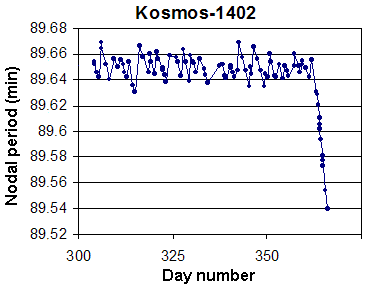


 The
ascent to high orbit
The
ascent to high orbit
 The
Kettering Group, to which I have belonged since
1966, initially had difficulties finding the signals from the US-A system, (see
separate article), but in 1975 two factors contributed
to success. First, my friend Dick Flagg purchased a 55-260 MHz telemetry receiver with a spectrum display
unit for me and had it shipped to Sweden. This was a powerful tool in
finding new signals. Within months of bringing that receiver in operation I had
identified PPM-AM telemetry on 166.0 MHz from US-A satellites.
The second factor was the launch of Kosmos-723 and Kosmos-724. These satellites
transmitted extensively including on short waves. Therefore the Kettering Group
finally found also the 19.542 MHz FSK-PDM telemetry from the US-A system when I succeeded
in picking up this signal from Kosmos-723 on 26 April 1975. As time went by we
were able to determine that the 166 MHz transmitter was in the main spacecraft
bus that remained in low orbit and the 19.542 MHz transmitter was placed in the
part of the spacecraft that was raised to the "storage" orbit (see Kosmos-1299
below). Observations of many US-A missions showed that the short-wave signals
were very rare during the low-orbit phase of the mission, but much more frequent
in the high orbit, "storage" phase of the flight. Perhaps the HF beacon was used
to monitor the status of the reactor. More details about telemetry receptions
and formats will be given below when each mission is examined.
The
Kettering Group, to which I have belonged since
1966, initially had difficulties finding the signals from the US-A system, (see
separate article), but in 1975 two factors contributed
to success. First, my friend Dick Flagg purchased a 55-260 MHz telemetry receiver with a spectrum display
unit for me and had it shipped to Sweden. This was a powerful tool in
finding new signals. Within months of bringing that receiver in operation I had
identified PPM-AM telemetry on 166.0 MHz from US-A satellites.
The second factor was the launch of Kosmos-723 and Kosmos-724. These satellites
transmitted extensively including on short waves. Therefore the Kettering Group
finally found also the 19.542 MHz FSK-PDM telemetry from the US-A system when I succeeded
in picking up this signal from Kosmos-723 on 26 April 1975. As time went by we
were able to determine that the 166 MHz transmitter was in the main spacecraft
bus that remained in low orbit and the 19.542 MHz transmitter was placed in the
part of the spacecraft that was raised to the "storage" orbit (see Kosmos-1299
below). Observations of many US-A missions showed that the short-wave signals
were very rare during the low-orbit phase of the mission, but much more frequent
in the high orbit, "storage" phase of the flight. Perhaps the HF beacon was used
to monitor the status of the reactor. More details about telemetry receptions
and formats will be given below when each mission is examined.  Kosmos-102 was launched
at 2219 UT on 27 December 1965 from site 31 at Baikonur by a version of
the R-7 rocket
Kosmos-102 was launched
at 2219 UT on 27 December 1965 from site 31 at Baikonur by a version of
the R-7 rocket  Kosmos-209 was launched from Baikonur at 0930 UT on 22
March 1968. The Kettering Group instantly spotted this satellite to be similar
to Kosmos-198. Here is what Geoff Perry wrote (21):
Kosmos-209 was launched from Baikonur at 0930 UT on 22
March 1968. The Kettering Group instantly spotted this satellite to be similar
to Kosmos-198. Here is what Geoff Perry wrote (21):
 Kosmos-469
Kosmos-469 Kosmos-723 & Kosmos-724
Kosmos-723 & Kosmos-724 Kosmos-785
Kosmos-785 Kosmos-951 & Kosmos-954, a
near-disaster
Kosmos-951 & Kosmos-954, a
near-disaster Kosmos-1249 &
Kosmos-1266
Kosmos-1249 &
Kosmos-1266 On 6 September
1981 picked up extremely strong short-wave telemetry on 19.542 MHz from
Kosmos-1299 of the pulsed type described above. The signals were received at
1730.45-1738.20 UT and 2103.54-2119.24 UT and were typical of over-the-horizon
receptions. During these receptions object A (cat nr 12783) was always above the
horizon, while object D (cat nr 12808) was well below the horizon at the end of
the second reception. This indicates that the short-wave
transmitter is in the main object in the high orbit, i.e. the boost rocket with
the empty reactor casing. This was confirmed a little more than a year later
during the flight of Kosmos-1402 (see below). Last signals on 19.542 MHz from
Kosmos-1299 were picked up by myself on 13 September 1981.
On 6 September
1981 picked up extremely strong short-wave telemetry on 19.542 MHz from
Kosmos-1299 of the pulsed type described above. The signals were received at
1730.45-1738.20 UT and 2103.54-2119.24 UT and were typical of over-the-horizon
receptions. During these receptions object A (cat nr 12783) was always above the
horizon, while object D (cat nr 12808) was well below the horizon at the end of
the second reception. This indicates that the short-wave
transmitter is in the main object in the high orbit, i.e. the boost rocket with
the empty reactor casing. This was confirmed a little more than a year later
during the flight of Kosmos-1402 (see below). Last signals on 19.542 MHz from
Kosmos-1299 were picked up by myself on 13 September 1981.  Kosmos-1402 was launched at 1004 UT on 30 August
1982 while Kosmos-1365 was still in operation in the low orbit. Therefore,
another launch was not expected immediately. Kosmos-1402 was launched into an
orbit co-planar with that of Kosmos-1365 and a time phase difference of 38.63
minutes (38.42 minutes is the ideal value for co-planar orbits with n=3). When
Kosmos-1365 was deactivated on 27 September a replacement for that satellite was
promptly launched when Kosmos-1412 was launched at 0000 UT on 2 October 1982.
The orbits of these two spacecraft were chosen to be almost co-planar
(difference 0.85 deg) with an initial phase difference time separation of 25.52
minutes, which is close to the theoretical value for co-planar orbits with n=2,
i.e. 25.6 minutes. However, Kosmos-1412 ended its mission on 10 November 1982
when it moved to the high orbit. Again, despite heroic efforts by Soviet
planners, a single US-A spacecraft was left in the operational orbit.
Kosmos-1402 "soldiered on" in this orbit until the end of December 1982 when
dramatic events occurred. The graph below shows how the spacecraft was split
into three pieces that all decayed instead of moving to the high
orbit.
Kosmos-1402 was launched at 1004 UT on 30 August
1982 while Kosmos-1365 was still in operation in the low orbit. Therefore,
another launch was not expected immediately. Kosmos-1402 was launched into an
orbit co-planar with that of Kosmos-1365 and a time phase difference of 38.63
minutes (38.42 minutes is the ideal value for co-planar orbits with n=3). When
Kosmos-1365 was deactivated on 27 September a replacement for that satellite was
promptly launched when Kosmos-1412 was launched at 0000 UT on 2 October 1982.
The orbits of these two spacecraft were chosen to be almost co-planar
(difference 0.85 deg) with an initial phase difference time separation of 25.52
minutes, which is close to the theoretical value for co-planar orbits with n=2,
i.e. 25.6 minutes. However, Kosmos-1412 ended its mission on 10 November 1982
when it moved to the high orbit. Again, despite heroic efforts by Soviet
planners, a single US-A spacecraft was left in the operational orbit.
Kosmos-1402 "soldiered on" in this orbit until the end of December 1982 when
dramatic events occurred. The graph below shows how the spacecraft was split
into three pieces that all decayed instead of moving to the high
orbit.
 By analyzing the
relative motion of these pieces it seems that the C object, presumably the fuel
core as we shall see later, seems to have separated at high speed (<10 m/s?)
from the main A object late (approx. 2200 UT) on 27 December 1982. A sign of
this can be seen in the graph above; the fuel core orbital period trace starts
at 89.4 minutes - well below the orbital period curve for the main object. The B
object, often called the rocket separated from the main object at about 0200 UT
on 28 December 1982. The last element set of Kosmos-1402 which shows an increase
of period relative to an earlier value is dated at 2250 UT on 27 December 1982.
So, it seems that in the hours around midnight of 27/28 December the last
orbit-correction maneuver was made, controllers realized that the spacecraft was
malfunctioning and the attempt to boost it to higher orbit took place, but
failed. However, the relative motion analysis appears strange. One would have
thought that the low-density "rocket" would have separated from the vehicle
before the fuel core. The main object would have ascended to high orbit and then
discarded the fuel core. Here, events seem reversed. It should be remembered
that the relative motion analysis is uncertain. It is based on single element
sets that could have errors in them.
By analyzing the
relative motion of these pieces it seems that the C object, presumably the fuel
core as we shall see later, seems to have separated at high speed (<10 m/s?)
from the main A object late (approx. 2200 UT) on 27 December 1982. A sign of
this can be seen in the graph above; the fuel core orbital period trace starts
at 89.4 minutes - well below the orbital period curve for the main object. The B
object, often called the rocket separated from the main object at about 0200 UT
on 28 December 1982. The last element set of Kosmos-1402 which shows an increase
of period relative to an earlier value is dated at 2250 UT on 27 December 1982.
So, it seems that in the hours around midnight of 27/28 December the last
orbit-correction maneuver was made, controllers realized that the spacecraft was
malfunctioning and the attempt to boost it to higher orbit took place, but
failed. However, the relative motion analysis appears strange. One would have
thought that the low-density "rocket" would have separated from the vehicle
before the fuel core. The main object would have ascended to high orbit and then
discarded the fuel core. Here, events seem reversed. It should be remembered
that the relative motion analysis is uncertain. It is based on single element
sets that could have errors in them.  On 6 January Soviet
media denied that anything was amiss with Kosmos-1402 "on a pre-planned course
and presented no danger" , but the following day they did admit the the
satellite was coming down. At 1700 MT the following statement was issued
by Moscow:
On 6 January Soviet
media denied that anything was amiss with Kosmos-1402 "on a pre-planned course
and presented no danger" , but the following day they did admit the the
satellite was coming down. At 1700 MT the following statement was issued
by Moscow:  The next phase of the
public excitement around the Kosmos-1402 mishap was the estimate of the re-entry
time. Orbital data were still scarce so people with only public domain
information were "fumbling in the darkness". On 10 January doubts as to what the
A and C parts were started to appear. Pierre Nierinck, a very skilled satellite
observer and orbital analyst based in Dunkirk, had calculated that the densities
of the A, B and C objects were related as B,A,C=1,10.2,24.5 showing that C was
the most dense objects. Pierre also calculated that the re-entries of the A and
C objects would be Jan 23 +/- 4 days for the A object and Feb. 7 +/7 days for
the C object
The next phase of the
public excitement around the Kosmos-1402 mishap was the estimate of the re-entry
time. Orbital data were still scarce so people with only public domain
information were "fumbling in the darkness". On 10 January doubts as to what the
A and C parts were started to appear. Pierre Nierinck, a very skilled satellite
observer and orbital analyst based in Dunkirk, had calculated that the densities
of the A, B and C objects were related as B,A,C=1,10.2,24.5 showing that C was
the most dense objects. Pierre also calculated that the re-entries of the A and
C objects would be Jan 23 +/- 4 days for the A object and Feb. 7 +/7 days for
the C object  The fact that the
reactor fuel core had been separated and that this new safety device had been
introduced to handle situation such as the earlier accident with Kosmos-954 was
not really known until the Soviet authorities said so in connection with
Kosmos-1402. Earlier evidence that an additional object appeared in the high
orbit after Kosmos-954 had not been interpreted as ejection of the fuel core.
The confusion in connection with Kosmos-1402 also showed that Western
intelligence sources had not correctly understood the redesign of the US-A
system at this time. In a UN document from 1980
The fact that the
reactor fuel core had been separated and that this new safety device had been
introduced to handle situation such as the earlier accident with Kosmos-954 was
not really known until the Soviet authorities said so in connection with
Kosmos-1402. Earlier evidence that an additional object appeared in the high
orbit after Kosmos-954 had not been interpreted as ejection of the fuel core.
The confusion in connection with Kosmos-1402 also showed that Western
intelligence sources had not correctly understood the redesign of the US-A
system at this time. In a UN document from 1980 Kosmos-1579 and Kosmos-1697, two single spacecraft
missions
Kosmos-1579 and Kosmos-1697, two single spacecraft
missions Kosmos-1736
Kosmos-1736 Although not revealed
immediately, it later turned out that this spacecraft was called Plazma-A and
tested the new TEU-5 Topol
Although not revealed
immediately, it later turned out that this spacecraft was called Plazma-A and
tested the new TEU-5 Topol  The second Plasma-A test
satellite, Kosmos-1867, was launched at 1535 UT on 10 July 1987. It initially
repeated the flight pattern of Kosmos-1818 and entered the 100.76 min repeating
pattern orbit. The period was maintained near 100.76 minutes for about 520 days.
Initially, there were large excursions of the orbital period around 100.76
minutes. During these excursions the period sometimes increased monotonically,
indicating continuous thrust by an electric rocket motor. Later the orbit was
maintain at rather steady values. During this later phase it seemed as if the
electric thruster (Plasma-2 SPT electric engine) was switched on and off. After
the 520 days of controlled orbit the natural decay started.
The second Plasma-A test
satellite, Kosmos-1867, was launched at 1535 UT on 10 July 1987. It initially
repeated the flight pattern of Kosmos-1818 and entered the 100.76 min repeating
pattern orbit. The period was maintained near 100.76 minutes for about 520 days.
Initially, there were large excursions of the orbital period around 100.76
minutes. During these excursions the period sometimes increased monotonically,
indicating continuous thrust by an electric rocket motor. Later the orbit was
maintain at rather steady values. During this later phase it seemed as if the
electric thruster (Plasma-2 SPT electric engine) was switched on and off. After
the 520 days of controlled orbit the natural decay started.
 Kosmos-1900 (Catalog
number 18665) was launched at 0540 UT on 12 December 1987. The parameters used
to describe the orbit of Kosmos-1900 are N,M,Q=16,-1,6, which means that the
ground track repeats every 95 revolutions. The resulting orbit has an average
altitude above a spherical earth of 262.1 km and a nodal period of 89.79
minutes.
Kosmos-1900 (Catalog
number 18665) was launched at 0540 UT on 12 December 1987. The parameters used
to describe the orbit of Kosmos-1900 are N,M,Q=16,-1,6, which means that the
ground track repeats every 95 revolutions. The resulting orbit has an average
altitude above a spherical earth of 262.1 km and a nodal period of 89.79
minutes.
 The final chapter - Sodium/Potassium coolant from
US-A satellites found in orbit
The final chapter - Sodium/Potassium coolant from
US-A satellites found in orbit Material data for NaK
usually is only given for parameter intervals being of some interest for
thermodynamic processes, and experiments to examine the effect of liquids
spraying into a vacuum have so far only been conducted for water. However, some
similarities between water and NaK, especially in terms of consistency, together
with the general lack of data, seem to justify adopting at least the basic
characteristics of the water droplet diameter distribution data for the NaK
problem. This assumption is also supported by the fact that the vapour pressure
of hot NaK (753 K) equals that of water at room temperature (293 K) ..."
Material data for NaK
usually is only given for parameter intervals being of some interest for
thermodynamic processes, and experiments to examine the effect of liquids
spraying into a vacuum have so far only been conducted for water. However, some
similarities between water and NaK, especially in terms of consistency, together
with the general lack of data, seem to justify adopting at least the basic
characteristics of the water droplet diameter distribution data for the NaK
problem. This assumption is also supported by the fact that the vapour pressure
of hot NaK (753 K) equals that of water at room temperature (293 K) ..."